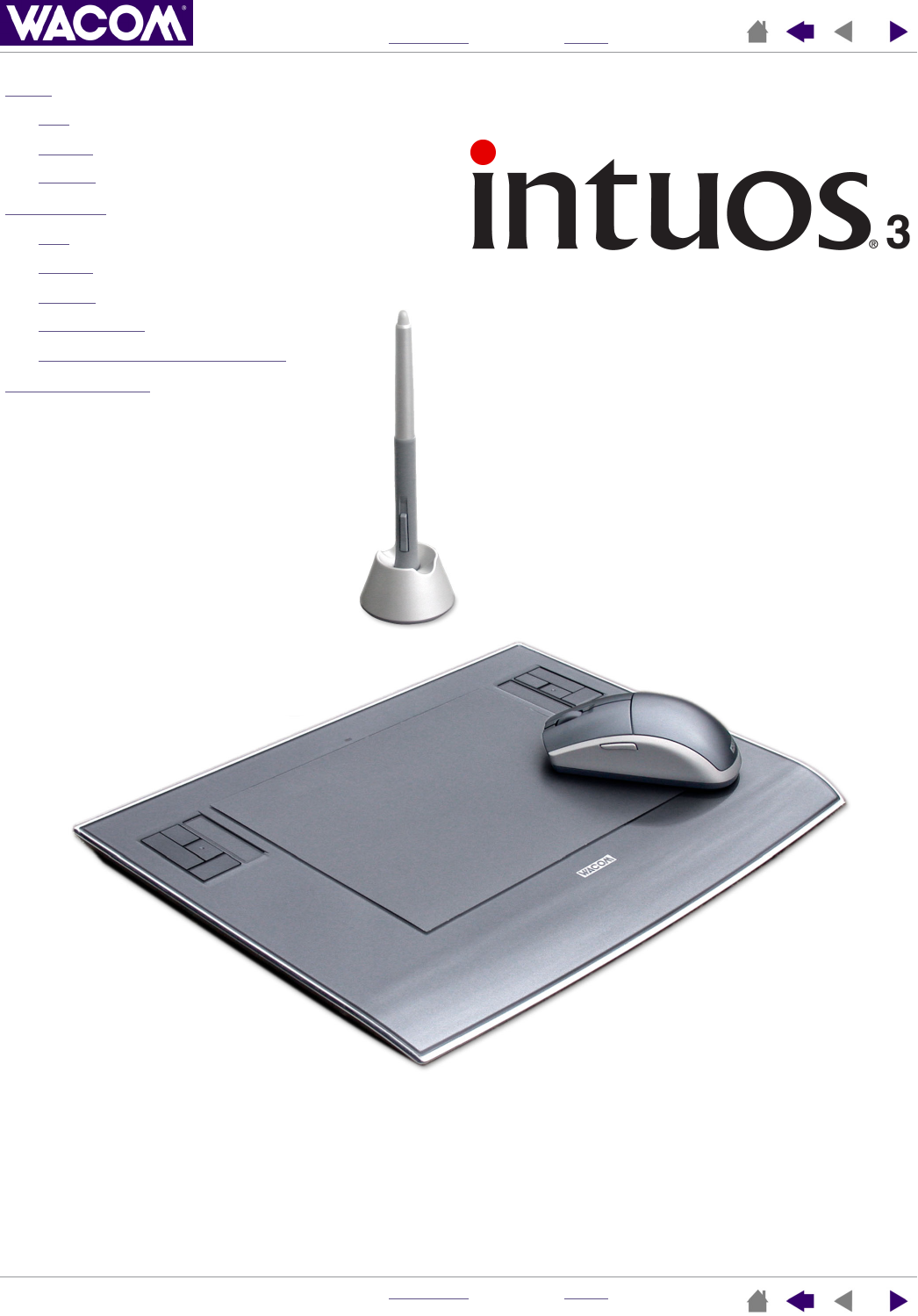Contents
- 1. USERS MANUAL 1
- 2. USERS MANUAL 2
- 3. USERS MANUAL
USERS MANUAL 1
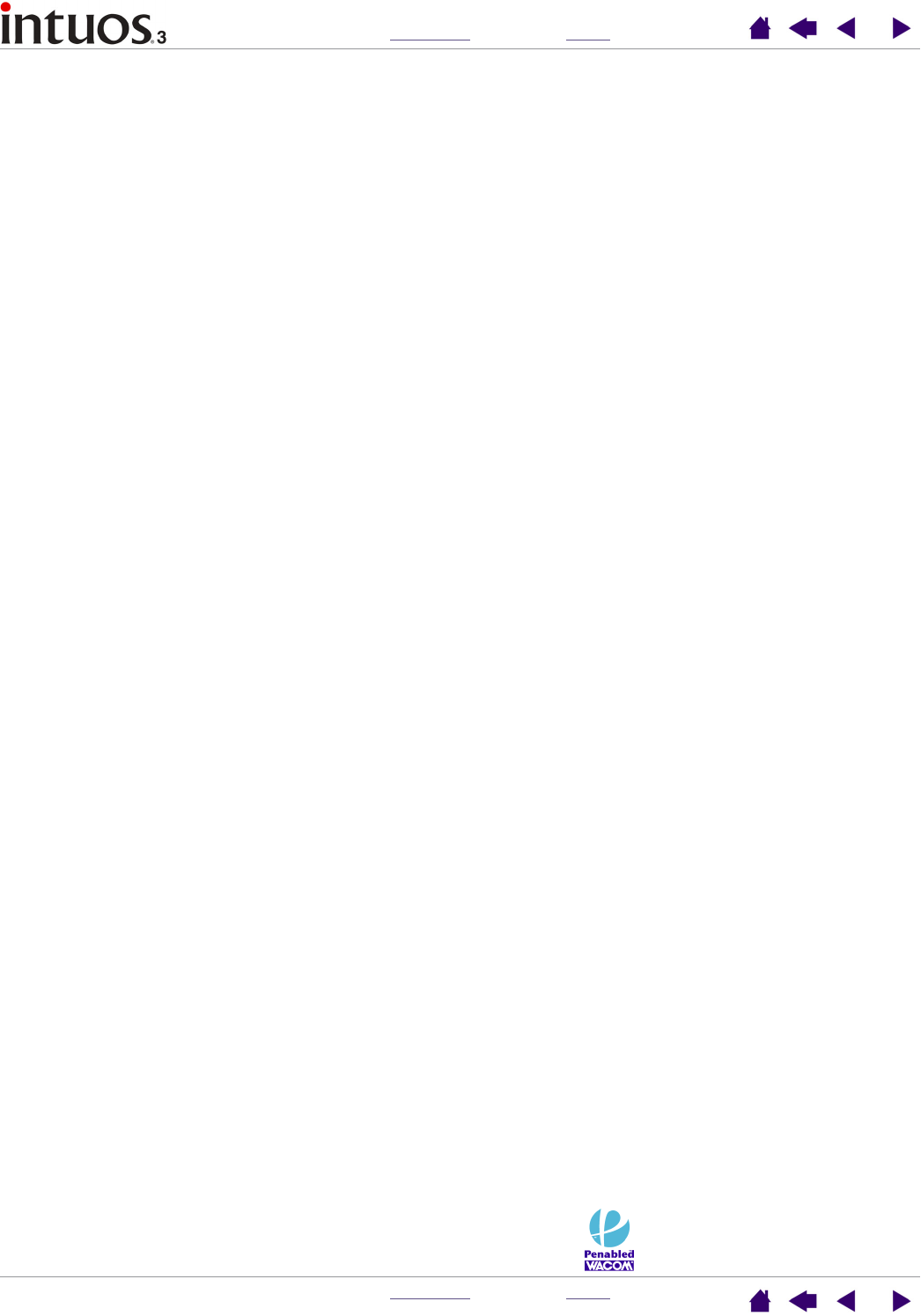
I
NDEX
C
ONTENTS
I
NDEX
C
ONTENTS
2
2
Wacom Intuos
®
3 User’s Manual for Windows
®
& Macintosh
®
English version 1.0, April 03, 2004
Copyright
WACOM Company, Limited, 2004
All rights reserved. No part of this manual may be reproduced except for your express personal use. Wacom reserves
the right to revise this publication without obligation to provide notification of such changes. Wacom does its best to
provide current and accurate information in this manual. However, Wacom reserves the right to change any
specifications and product configurations at its discretion, without prior notice and without obligation to include such
changes in this manual.
Penabled, Tool ID, QuickPoint, and DuoSwitch are trademarks, and Intuos and Wacom are registered trademarks of
WACOM Company, Limited.
Adobe, Acrobat, Reader, and Photoshop are either registered trademarks or trademarks of Adobe Systems
Incorporated in the United States and/or other countries. Microsoft and Windows are either registered trademarks or
trademarks of Microsoft Corporation in the United States and/or other countries. Apple, the Apple logo, and Macintosh
are registered trademarks of Apple Computer, Inc., registered in the U.S. and other countries. Any additional company
and product names mentioned in this documentation may be trademarked and/or registered as trademarks. Mention of
third-party products is for information purposes only and constitutes neither an endorsement nor a recommendation.
Wacom assumes no responsibility with regard to the performance or use of these products.
Watch for the Penabled logo to ensure you
are getting the natural feel and superior
performance of Wacom’s patented cordless
and battery-free pen technology.

I
NDEX
C
ONTENTS
I
NDEX
C
ONTENTS
3
3
CONTENTS
About the manual 5
Navigating the manual 6
WORKING WITH INTUOS3 7
Intuos3 tablet features 8
Intuos3 input tools 9
Intuos3 optional tools 10
Setting up your work area 11
Using the Grip Pen 12
Holding the Pen 12
Pointing 13
Clicking 14
Dragging 14
Using the side switch 15
Drawing with pressure-sensitivity 16
Drawing with tilt 16
Erasing 17
Eye-hand coordination exercise 18
Using the Mouse 19
Using the Airbrush 20
Working with the tablet 21
Using the Tablet Keys 22
Using the Touch Strips 23
CUSTOMIZING 24
Opening the control panel 24
Control panel overview 25
Control panel settings 26
Customizing the Pen 27
Adjusting tip feel and double-click 28
Adjusting eraser feel 29
Advanced tip and eraser pressure settings 30
Customizing tool buttons 31
Button functions 32
Customizing tilt sensitivity 35
Customizing the Mouse 36
Customizing Mouse buttons 36
Customizing the Mouse fingerwheel 37
Tablet to screen mapping 38
Pen mode 38
Mouse mode 39
Orientation 39
Screen area 40
Force proportions 41
Tablet area 42
Mapping to multiple monitors 43
Customizing the tablet functions 44
Customizing Tablet Keys 45
Customizing tablet Touch Strips 46
Advanced Touch Strip settings 49
Customizing the Pop-up Menu 50
Working with multiple tools 51
Working with application-specific settings 52
Creating an application-specific setting 53
Changing settings for a specific tool
and application 54
Removing application-specific settings 54
TROUBLESHOOTING 55
Testing your tablet 56
Testing your tools 57
Testing the Tablet Keys 58
Testing the tablet Touch Strips 58
Testing a Pen 59
Testing a Mouse 60
Troubleshooting tables 61
General problems 61
Windows-specific problems 64
Macintosh-specific problems 65
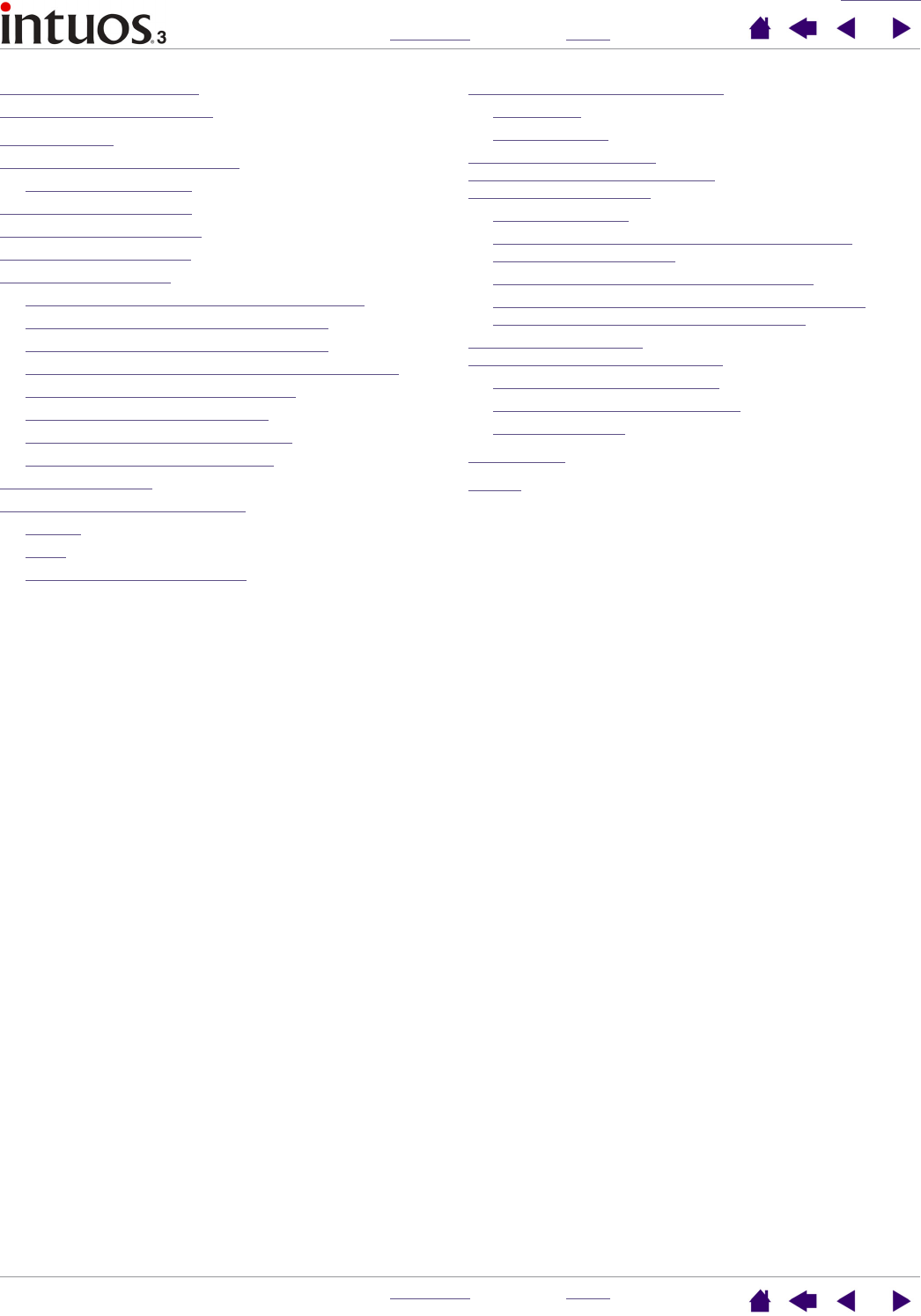
C
ONTENTS
I
NDEX
C
ONTENTS
I
NDEX
C
ONTENTS
4
4
Technical support options 67
Obtaining driver downloads 68
APPENDICES 69
Caring for your tablet and tools 69
Replacing the Pen tip 70
Uninstalling the software 70
Changing the tablet mode 71
Installing multiple tablets 71
Product specifications 72
General specifications for all Intuos3 tablets 72
Intuos3 4x5/A6 tablet (model PTZ-430) 72
Intuos3 6x8/A5 tablet (model PTZ-630) 72
Intuos3 9x12/A4-regular tablet (model PTZ-930) 72
Intuos3 Grip Pen (model ZP-501E) 73
Intuos3 Mouse (model ZC-100) 73
Intuos3 Airbrush (model ZP-400E) 73
Intuos3 Ink Pen (model ZP-130) 73
Product information 74
Ordering parts and accessories 74
Tablets 75
Tools 75
Other parts and accessories 76
Radio and television interference 77
FCC notice 77
CE declaration 77
License and Warranties
(Worldwide, Except for Europe,
Africa and Middle East) 78
Software License 78
Limited Warranty (Worldwide, Except Europe,
Africa and Middle East) 78
Warranty Service in the U.S. and Canada 80
Warranty on Sales Outside of U.S. and Canada
(Except Europe, Africa and Middle East) 80
License and Warranty
(Europe, Africa and Middle East) 81
Software License Agreement 81
Entitlement to Use the Software 81
Limited Warranty 81
GLOSSARY83
INDEX85

I
NDEX
C
ONTENTS
I
NDEX
C
ONTENTS
5
5
About the manual
This combined interactive User’s Manual for Windows and Macintosh provides quick access to information
about Intuos3. Just click on a navigation button or highlighted word to move through the document.
The information is common to both platforms and Windows screen captures are shown, unless otherwise
noted.
• In the contents you can go directly to a topic by clicking on it.
•Working with Intuos3 is the learning chapter, and introduces you to the many capabilities of your Intuos3
tablet. It describes the various tablet models, the features and functions of each Intuos3 tool, and
includes exercises for new users.
•Customizing describes how you can change the control panel settings to optimize your Intuos3 tablet
and tools for the way you like to work.
•Want to test your tablet and tools? Need troubleshooting guidelines? Troubleshooting is where you will
find the answers to most common questions.
• The appendices include a variety of information: tips on caring for your tablet and tools, a how-to on
uninstalling the software, your license and warranty, and more. If you are using more than one tablet on
your computer, you will find instructions on adding and working with multiple tablets.
Note:
This manual does not contain information on installing your tablet. Please refer to your product Quick
Start Guide and to the automated software installer (located on the Wacom Tablet CD) for details on
installing your Wacom tablet.
If you are new to electronic documentation, be sure to read navigating the manual.
Here are some other points to keep in mind:
• The tablet size descriptions shown within this manual reflect usage for both the USA and European
markets, and are separated by a “/ “. For example, in the descriptor “4x5/A6”, “4x5” is the tablet sizing
descriptor for markets in the USA. “A6” is the descriptor for European markets. Within this manual, USA
tablet size descriptors are always shown before the “/ “.
•S
MALL
CAPITAL
LETTERS
are used to identify the names of keyboard keys, dialog boxes, and control panel
options.
• Remember that you can always use the Adobe Reader zoom-in tool to increase the size of the manual
on your display screen.
• The following kinds of information are not included with this product: information about your specific
computer hardware or operating system, or information about your application software. Your best
source for this information is the set of manuals and disks that came with your hardware, operating
system, or application.
• Many graphics applications have built-in support for Intuos3 features (such as pressure-sensitivity, tilt,
airbrush simulation, and fingerwheel input for the Intuos3 Mouse). You can find a listing of applications
that support these features at Wacom’s web site (see product information). For information on how best
to use Intuos3 features within a specific application, refer to the instructions in that application’s
manuals.

I
NDEX
C
ONTENTS
I
NDEX
C
ONTENTS
6
6
Navigating the manual
Use the navigation controls to move through the manual:
Go to front page.
Go to table of contents.
Go to index.
Go back to previous view.
Page back, or page forward.
Go to beginning of section.
Go to topic.
Topic continued.
Adobe Reader provides you with additional tools for using and printing the manual. Refer to the Adobe
Reader help for more information.
CONTENTS
INDEX
HEADING TEXT
topic

I
NDEX
C
ONTENTS
I
NDEX
C
ONTENTS
7
7
WORKING WITH INTUOS3
This section introduces you to the Intuos3 professional pen tablet. Intuos3 consists of a tablet that serves as
your work area and the Intuos3 input tools you use on the tablet. The quickest way to learn about Intuos3 is
to become familiar with its appearance and features. If you are new to using a pen tablet, read the following
sections to learn about your Intuos3 tools and how to use them with the tablet.
Note:
Intuos3 tools will only work on an Intuos3 tablet. They will not work on an Intuos or Intuos2 series
tablet. Likewise, older Intuos or Intuos2 input tools will not work on your Intuos3 tablet.
Intuos3 tablet features
Intuos3 input tools
Setting up your work area
Using the Grip Pen
Using the Mouse
Using the Airbrush
Working with the tablet
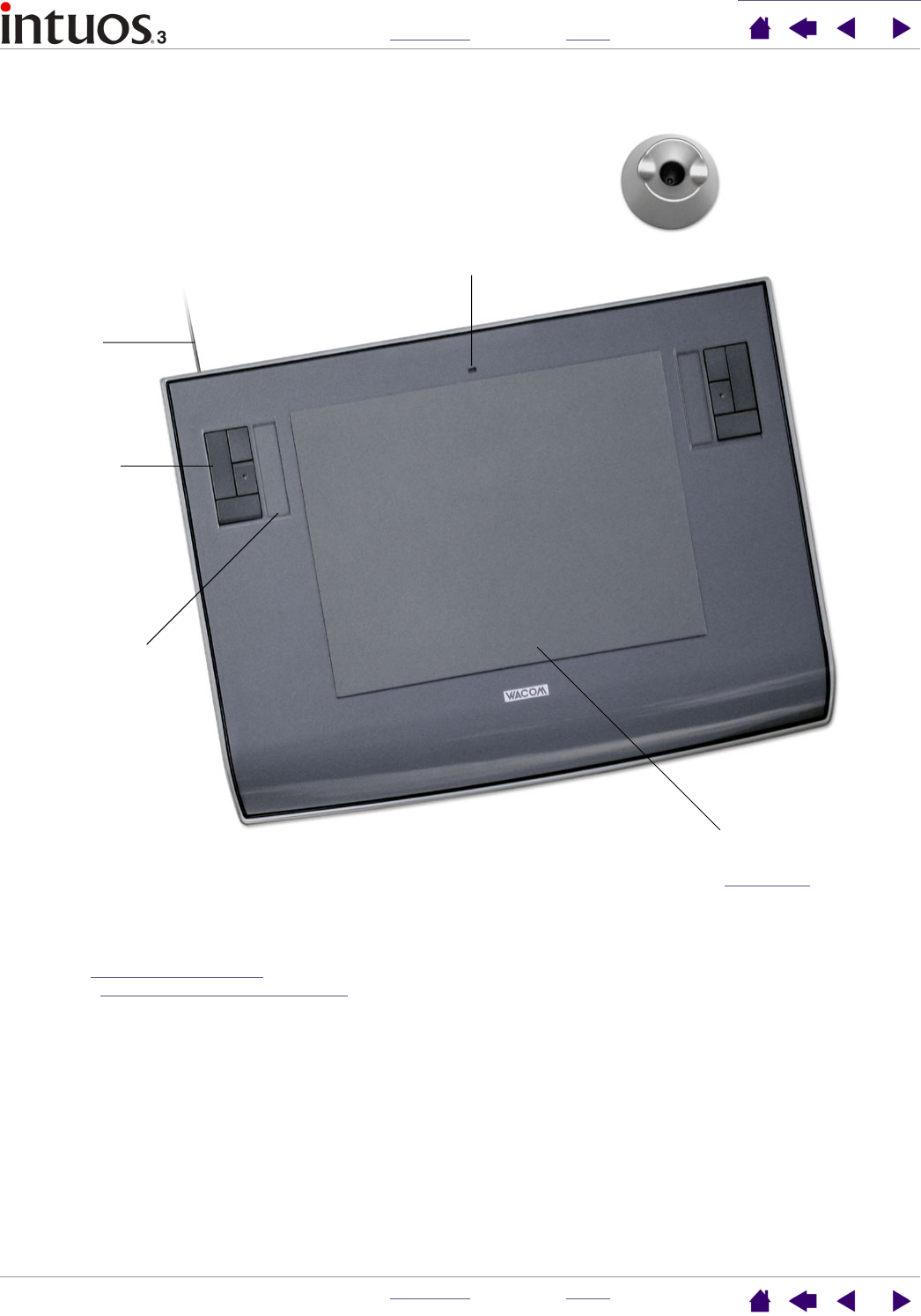
W
ORKING
WITH
I
NTUOS
3
I
NDEX
C
ONTENTS
I
NDEX
C
ONTENTS
8
8
Intuos3 tablet features
Note: Intuos3 6x8/A5 tablet shown. To learn more about your
tablet, see working with the tablet. For a complete listing of Intuos3
tablets, see ordering parts and accessories.
Touch Strip controls
Note: 4x5/A6 tablet
models come equipped
with Tablet Keys and a
single Touch Strip
located to the left of the
tablet’s active area.
Status LED
Tablet work surface
Identifies the tablet
active area.
Cable
Recessed cable
tracks on the back
of the tablet allow
the cable to exit
the top or left of
the tablet.
Pen stand
Customizable
Tablet Keys
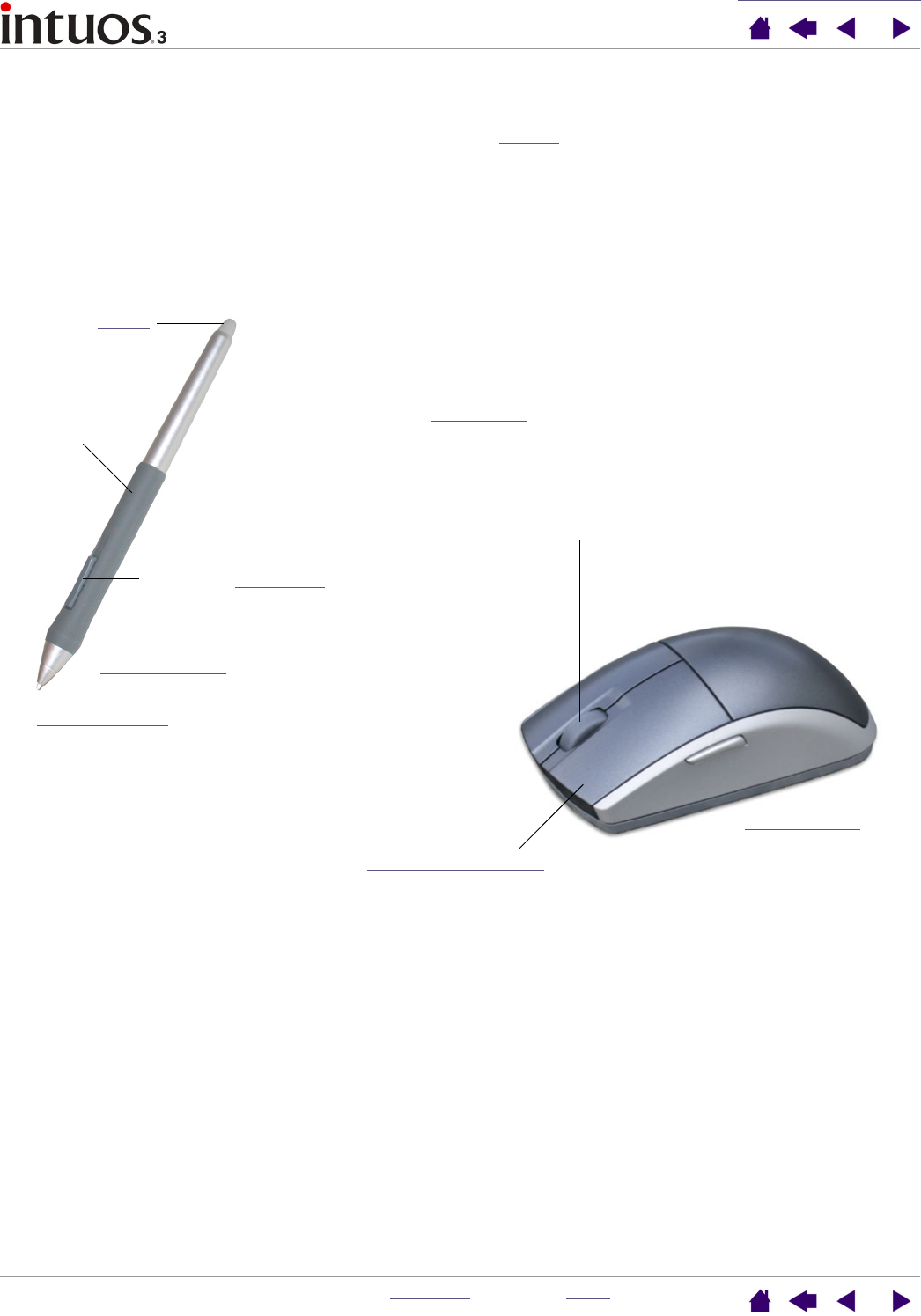
W
ORKING
WITH
I
NTUOS
3
I
NDEX
C
ONTENTS
I
NDEX
C
ONTENTS
9
9
Intuos3 input tools
Various input tools are available for your tablet. All Intuos3 tools are cordless, batteryless, and
ergonomically designed. Each tool also features a unique Tool ID, which enables you to work with multiple
tools and to customize each tool differently.
The Intuos3 Grip Pen is a pressure-sensitive freehand tool for image editing and creating natural-looking
pen and brush strokes.
If you prefer to use a mouse for general navigation, pointing, and clicking, just set aside your Intuos3 Pen
and place the Intuos3 Mouse on the tablet – the mouse is cordless and symmetrically designed so you can
use it just as easily in your left or right hand.
Eraser
Replaceable nib
(standard or stroke tip)
Removable DuoSwitch
(rocker style)
Intuos3 Grip Pen
Rubberized
grip area
Intuos3 Mouse
Programmable buttons can be
customized for the way you like to work.
Fingerwheel. An integrated
middle button and rolling
wheel that can be used for
up and down scrolling in the
active window. It can also
be customized to perform a
variety of button functions.
Note: Some product configurations may not include the Intuos3 Mouse.
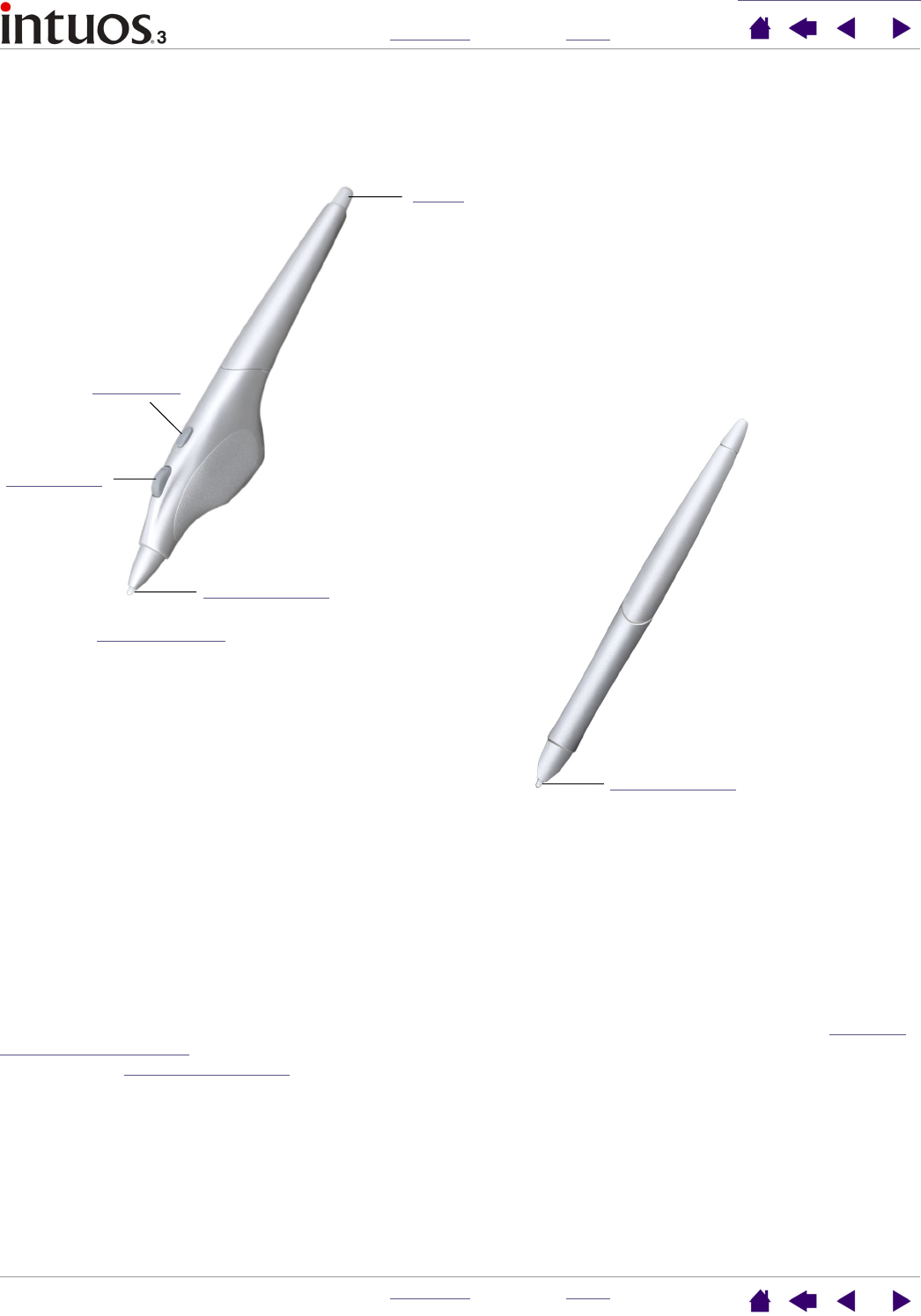
W
ORKING
WITH
I
NTUOS
3
I
NDEX
C
ONTENTS
I
NDEX
C
ONTENTS
10
10
Intuos3 optional tools
Like the Intuos3 Grip Pen, the optional Airbrush is a pressure-sensitive freehand tool for image editing and
creating natural-looking pen and brush strokes.
For information on these and other available Intuos3 tablets, tools, or parts and accessories, see ordering
parts and accessories. Visit Wacom’s web site for a list of applications supporting the Ink Pen and Airbrush
features. See product information.
Intuos3 Airbrush (optional accessory)
Eraser
Replaceable nib
Side switch
Fingerwheel
Replaceable nib
(standard or inking tip)
Intuos3 Ink Pen (optional accessory)
The Ink Pen is pressure-sensitive and comes with
replaceable inking cartridges. With the Ink Pen you
can write or draw as you do with a regular pen – just
place a sheet of paper on your tablet and everything
you write will be captured on paper and on your
computer.
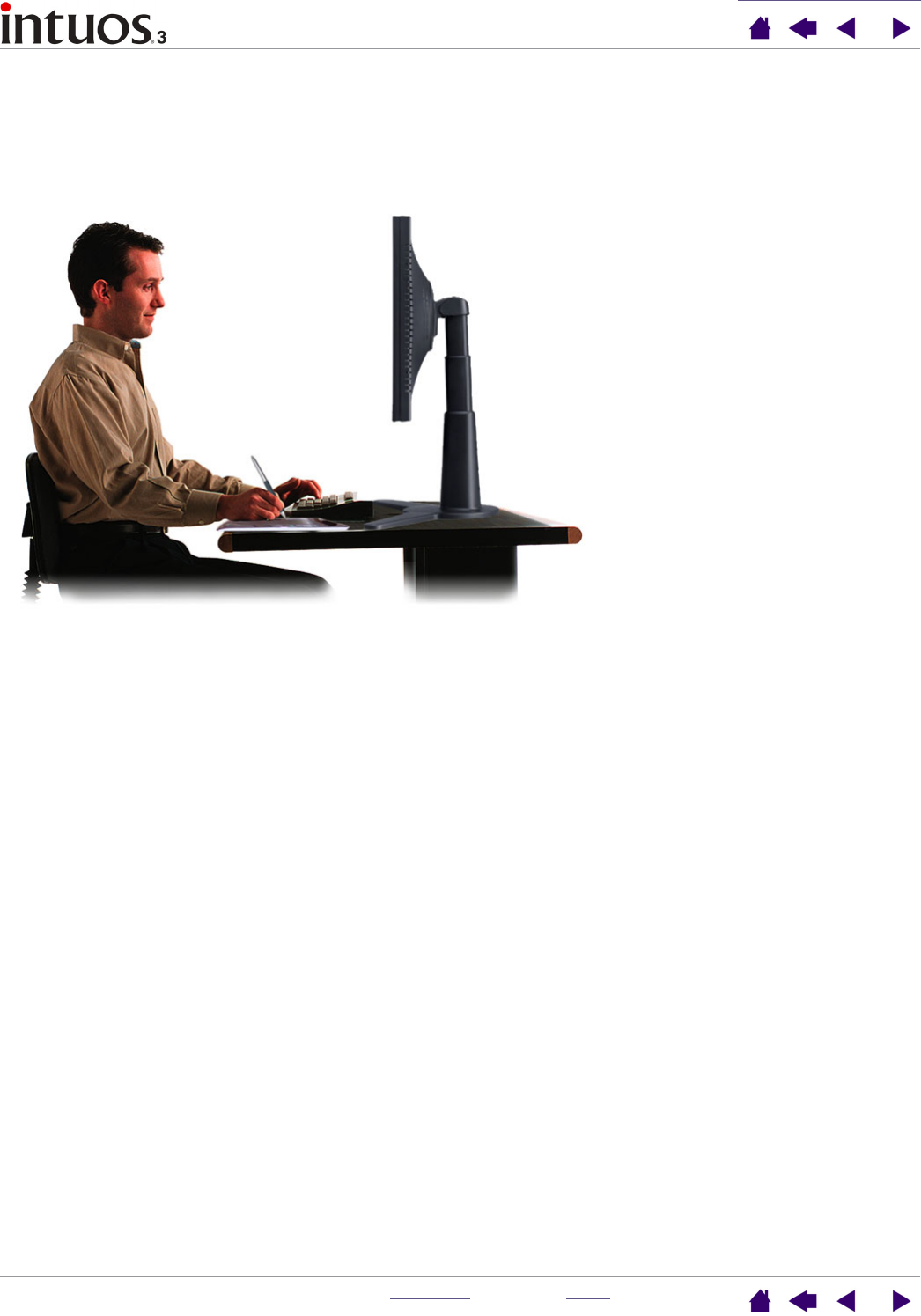
W
ORKING
WITH
I
NTUOS
3
I
NDEX
C
ONTENTS
I
NDEX
C
ONTENTS
11
11
Setting up your work area
To minimize fatigue, organize your work area so you can work comfortably. Position your tablet, input tools,
and keyboard so they are easily accessible without unnecessary reaching. Your monitor should be
positioned so you can view it comfortably with a minimum of eyestrain. For best results, orient the tablet so
the screen cursor follows the same direction as your hand movements on the tablet.
Note:
Wacom makes no representation, promise or guarantee that Wacom products will cure or prevent, in
whole or in part, mouse-induced repetitive stress symptoms, injuries or conditions. Individual results may
vary. Always obtain competent medical advice to determine the most appropriate treatment for your specific
situation.
See working with the tablet for additional information.
Here are some other points to keep
in mind:
•Take short breaks between
tasks to stretch and relax your
muscles.
• Use a gentle grip when working
with your tools.
• Alternate tasks and tools
throughout the day.
• Maintain a good posture at all
times. Minimize awkward
postures and repetitive
movements that cause
discomfort.
• Change your position if you feel
any discomfort due to your work
position.
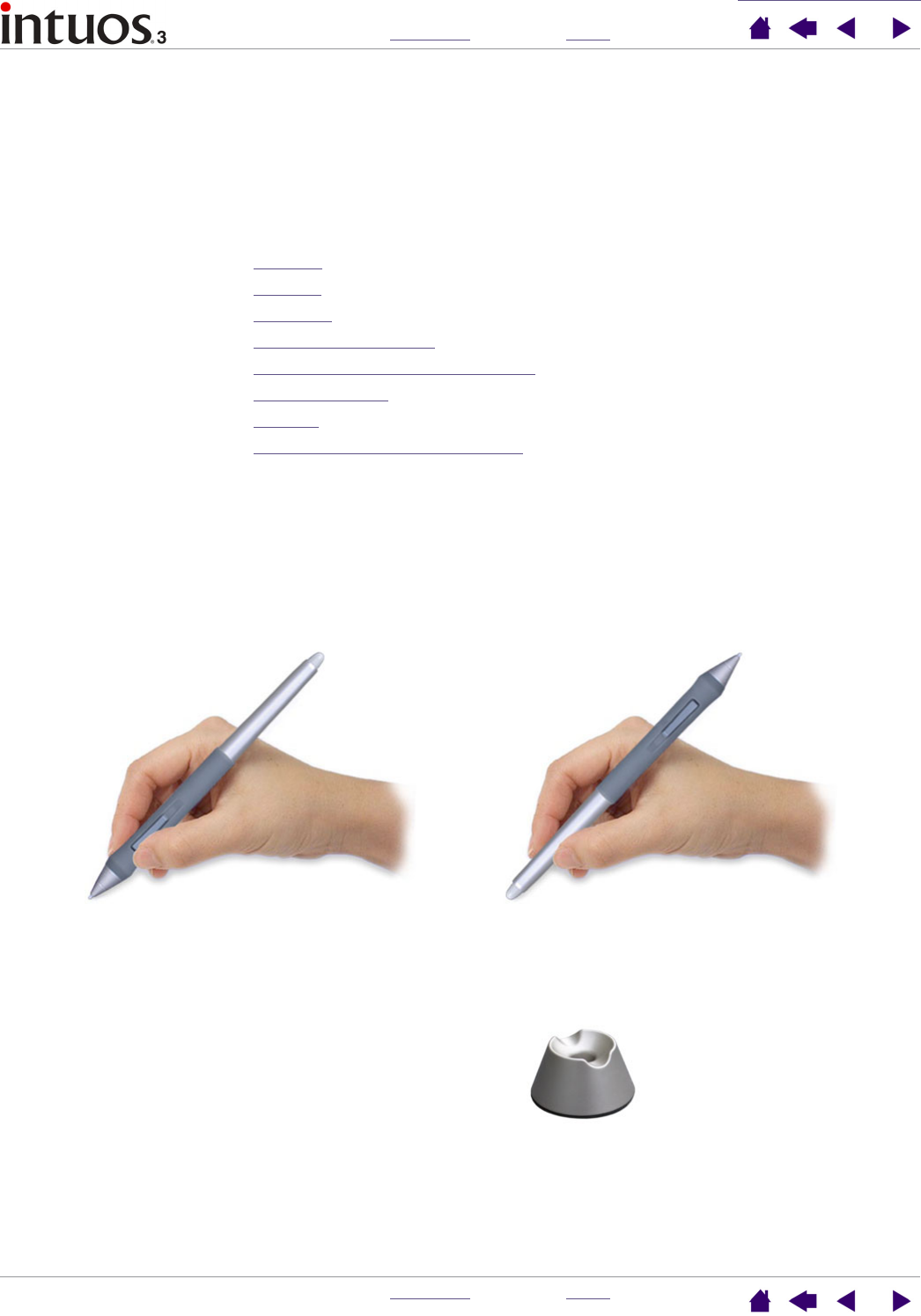
W
ORKING
WITH
I
NTUOS
3
I
NDEX
C
ONTENTS
I
NDEX
C
ONTENTS
12
12
Using the Grip Pen
The Intuos3 Grip Pen is cordless, batteryless, and pressure sensitive. There are four basic techniques for
using the pen: pointing, clicking, double-clicking, and dragging. With a bit of practice, using the pen will
become second nature to you. If you are unfamiliar with using the pen, try the exercises on the following
pages.
Holding the Pen
Pointing
Clicking
Dragging
Using the side switch
Drawing with pressure-sensitivity
Drawing with tilt
Erasing
Eye-hand coordination exercise
Holding the Pen
Hold the Intuos3 Pen like you would a normal pen or pencil. Make sure the DuoSwitch is in a convenient
location where you can toggle it with your thumb or forefinger, but not accidently press the switch while
drawing. You can tilt the pen in any way that feels most comfortable for drawing.
Position for drawing Position for erasing
Your tablet comes with a free-standing pen stand that is used to
hold your pen when it is not in use. Position the pen stand within
easy reach of your tablet. When you are between tasks, store
the pen either horizontally or vertically in the pen stand; this
makes the pen available for quick, easy access when you are
working.
Important: When the Intuos3 Pen is not in use, place it
in the pen stand or lay it flat on your desk. To maintain
the sensitivity of your pen tip, do not store the pen in a
container where it will rest on its tip. Leaving an Intuos3
tool on the tablet may interfere with screen cursor
positioning when using other pointing devices.
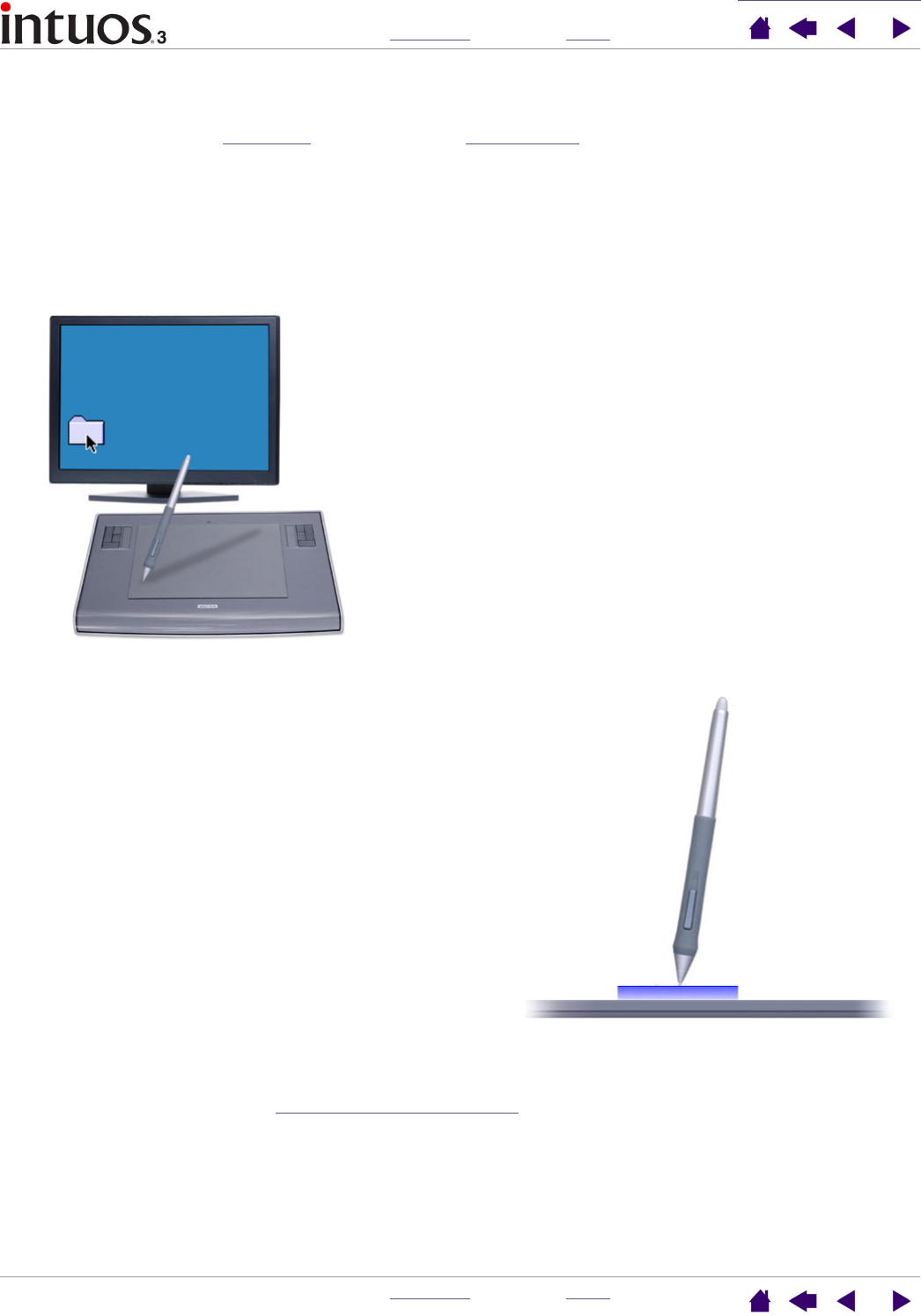
W
ORKING
WITH
I
NTUOS
3
I
NDEX
C
ONTENTS
I
NDEX
C
ONTENTS
13
13
Pointing
The Intuos3 Pen positions the pointer (or cursor) on your screen. You can position the screen cursor two
different ways, like a pen (P
EN
mode) or like a mouse (M
OUSE
mode).
• In P
EN
mode, the tablet’s active area is a mapped representation of your computer screen where every
point on the active area corresponds to exactly one point on the display screen; wherever you place the
pen on the tablet, the screen cursor will jump to the corresponding point on the screen. This is the
default setting for the pen.
•In M
OUSE
mode, the default setting for the Intuos3 Mouse, you move the cursor with a “pick up and slide”
action similar to using a traditional mouse.
Try moving the screen cursor by lifting the pen and
placing the pen tip in a new location on the tablet.
The cursor instantly jumps to the new location.
6 mm (0.25 inch)
Hints:
• If you are used to working with a mouse and find that using a pen is somewhat difficult,
try the eye-hand coordination exercise.
•Pointing is easier when you orient the tablet so the screen cursor follows the same
direction as your hand movements on the tablet.
When positioning the screen cursor and operating the side
switch, the pen tip needs to be within 6 mm (0.25 inch) of
the tablet surface. You do not need to touch the tablet with
the pen tip in order to move the screen cursor or use the
side switch.
All Intuos3 tools, including the mouse, work only over the
active area of the tablet.
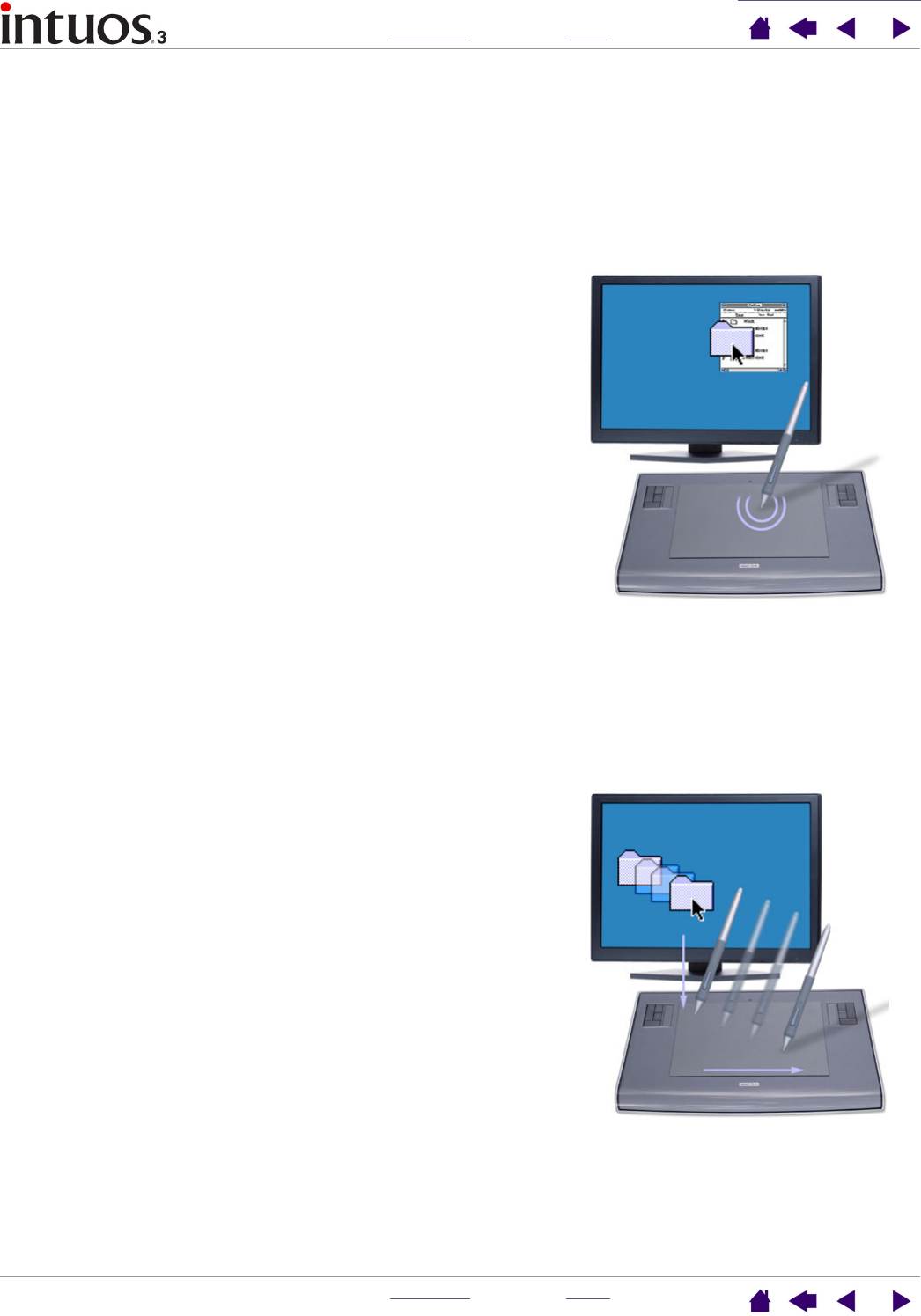
W
ORKING
WITH
I
NTUOS
3
I
NDEX
C
ONTENTS
I
NDEX
C
ONTENTS
14
14
Clicking
You typically click to highlight or select something on the screen, and double-click to open it.
Clicking.
To click, tap the pen tip once on the tablet, or press the pen tip on the tablet with enough force to
register a click. (There is no audible pen tip “click” sound.) Try clicking on a folder icon by moving the screen
cursor over the icon and pressing down on the pen tip. The folder should highlight when you press.
Double Clicking.
To double-click, quickly tap the tablet twice in the same place with the pen tip. This is like
clicking twice with a mouse button. Try double-clicking on a folder icon to open it.
Dragging
Dragging is used to select and move objects on the screen. To drag, first point to an object. Then press the
pen tip to the tablet and slide it across the tablet surface. The selected object will move across the screen.
To select text, move the screen cursor to the beginning of a text line, then drag the pen across the tablet until
the text is highlighted.
Hints:
• Press the upper side switch to double-click in Windows, or the
lower switch to double-click on Macintosh systems. This is easier
than tapping twice with the pen tip, and is the preferred method of
double-clicking with a pen.
•Windows: You can make navigating with the pen easier by
configuring Windows to select when the pen is over an icon and
to launch the icon with a single click. To turn on this feature:
Windows Me, 2000, or XP: Open a folder, select the TOOLS pull-
down menu, and FOLDER OPTIONS.... From the GENERAL tab
select the option SINGLE-CLICK TO OPEN AN ITEM (POINT TO
SELECT).
Windows 98: Open a folder, select the VIEW pull-down menu,
and FOLDER OPTIONS.... From the GENERAL tab select the WEB
STYLE option.
First, try moving an icon on the screen. Then, within a
document, select some text by pressing and dragging
the pen tip across the text.
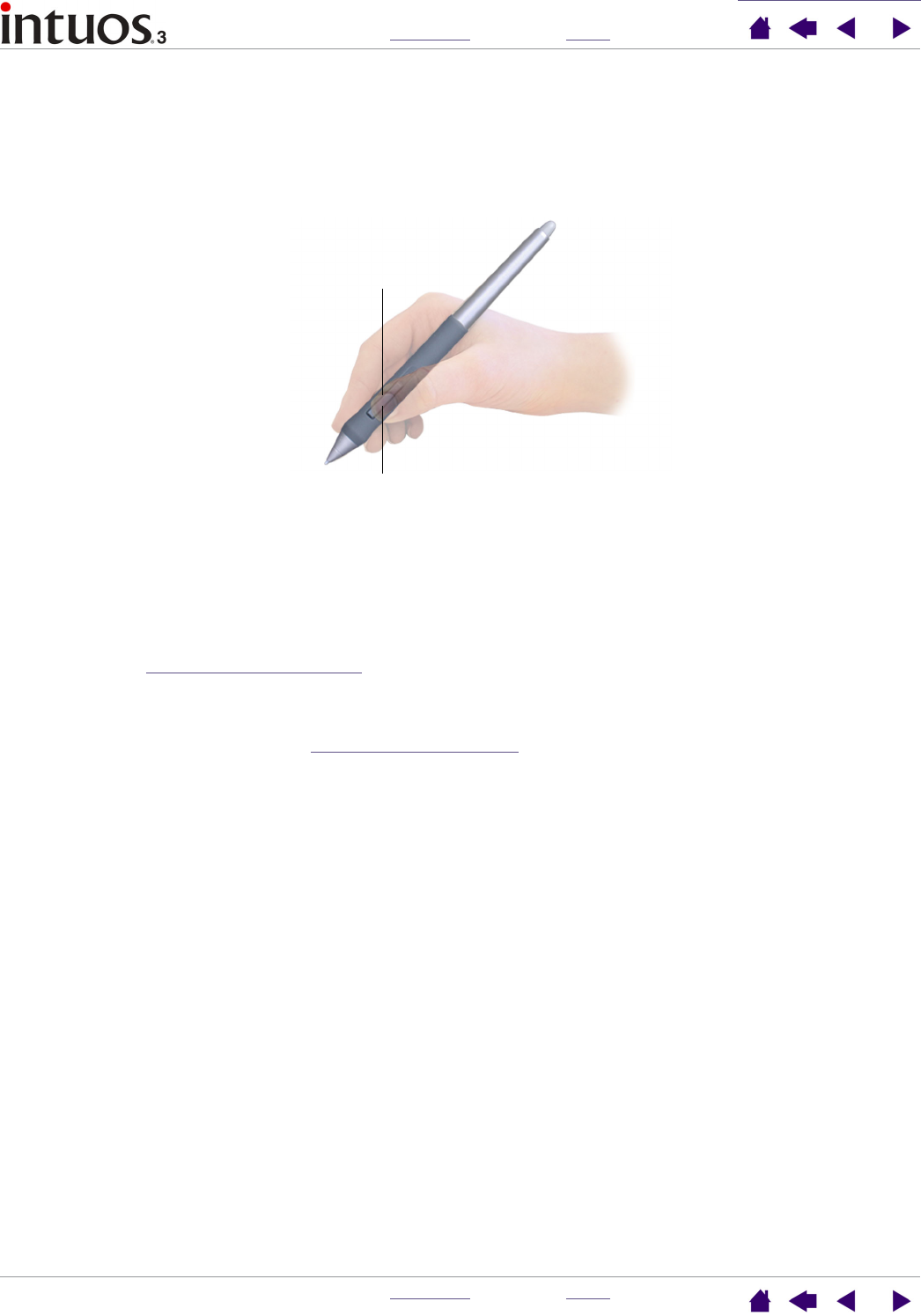
WORKING WITH INTUOS3
INDEX
CONTENTS
INDEX
CONTENTS 15
15
Using the side switch
The Intuos3 Grip Pen is equipped with a DuoSwitch. This switch has two programmable functions that can
be selected by rocking the switch in either direction. You can use the DuoSwitch whenever the pen tip is
within 6 mm (0.25 inch) of the tablet’s active area. You do not have to touch the pen tip to the tablet in order
to use the switch.
To assign new switch functions, see customizing tool buttons.
Hint: Press the upper side switch to double-click in Windows, or the lower side switch to
double-click on Macintosh systems. This is easier than tapping twice with the pen tip.
Note: The DuoSwitch on the Grip Pen can be removed if you do not need the switch
functionality. See other parts and accessories for information on ordering an alternate pen
grip for use with the side switch removed.
Windows: The upper switch position is set to DOUBLE-CLICK,
and the lower switch is set to RIGHT-CLICK by default.
Macintosh OS X: The upper switch is set to INK TOGGLE,
and the lower switch is set to DOUBLE-CLICK by default.
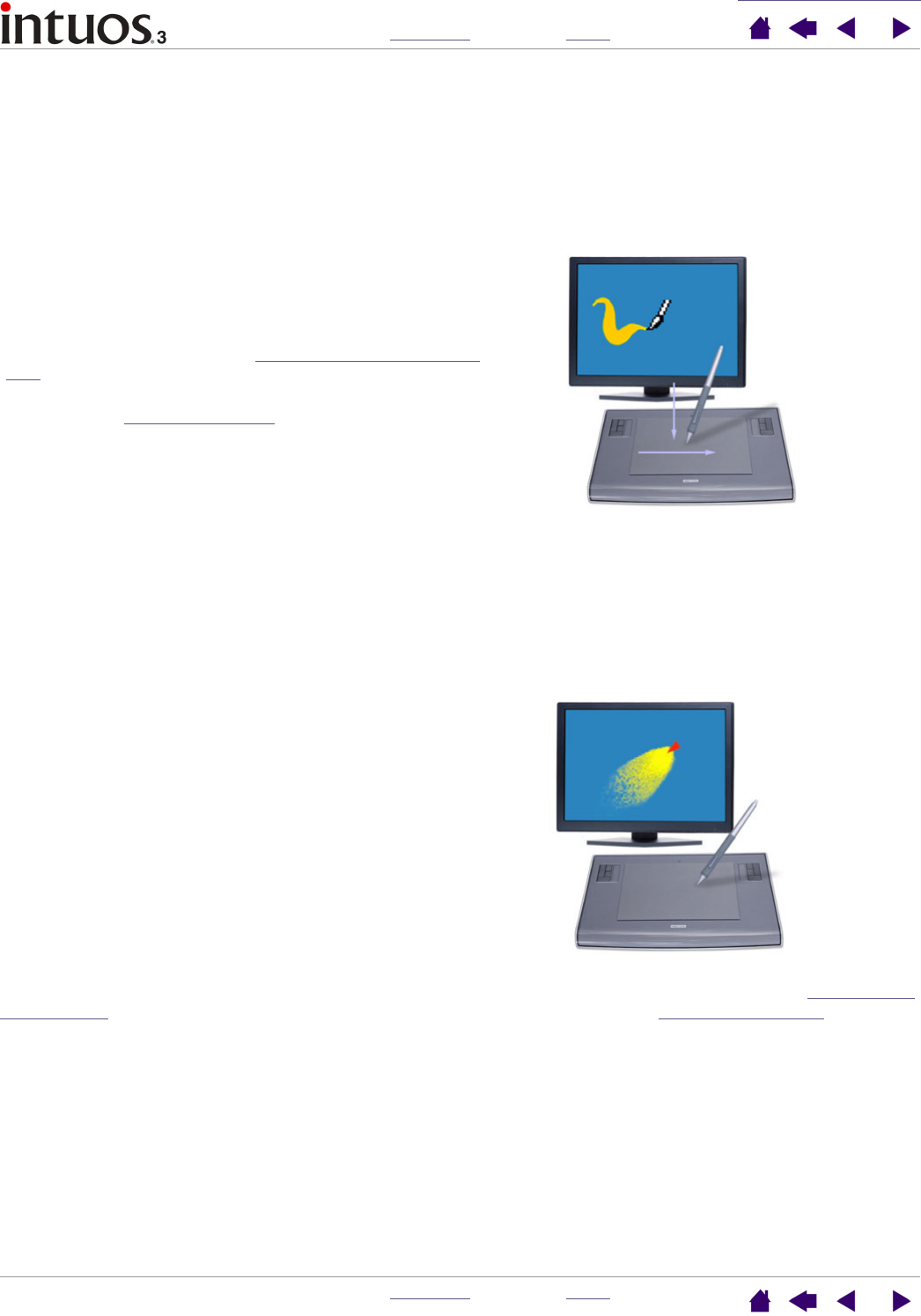
WORKING WITH INTUOS3
INDEX
CONTENTS
INDEX
CONTENTS 16
16
Drawing with pressure-sensitivity
The Intuos3 Pen responds to the nuance and inflection of your hand movements, enabling you to create
natural-looking pen and brush strokes. Many graphics applications have drawing tools that respond to the
pressure you place on the pen. For example, in some drawing programs sliders are used to vary brush
characteristics (width, color, and opacity). These characteristics can be controlled much better by the pen’s
pressure-sensitivity – you can vary line width, blend colors, and change opacity with the pressure you exert
upon the pen.
Drawing with tilt
As with pressure-sensitivity, the tablet recognizes when you tilt the pen from vertical to inclined positions.
In some drawing applications, tilt can be used to control line shape and thickness. This is like working with
an airbrush where tilt can be used to make a line thin when the tool is vertical, or wide when the tool is tilted.
In other applications, you can adjust tilt to define brush characteristics such as width, color and opacity.
To adjust the amount of pen tilt required to produce a desired tilt effect in your application, see customizing
tilt sensitivity. Visit our web site for a list of applications that support tilt. See product information.
To draw with pressure-sensitivity, first select a pressure-
sensitive tool from your application’s tool palette. Then draw
along the surface of the tablet while applying various amounts
of pressure downward on the tip of the pen. Press hard for
thick lines or dense color. Press gently for thin lines or softer
color. To adjust the tip feel, see adjusting tip feel and double-
click.
Visit our web site for a list of graphics applications that support
pressure. See product information.
To test tilt, draw a curve in a graphics application (such as
Painter) that supports tilt. Be sure that the tilt function in
your application is active, then change the tilt of the pen as
you draw to vary the shape and thickness of the brush
stroke.
As an example, when the brush shape dynamics in
Photoshop have been configured for tilt operation, tilting
the pen results in an elongated pattern. This simulates
the effects of an airbrush spray that is angled away from
the paint surface.
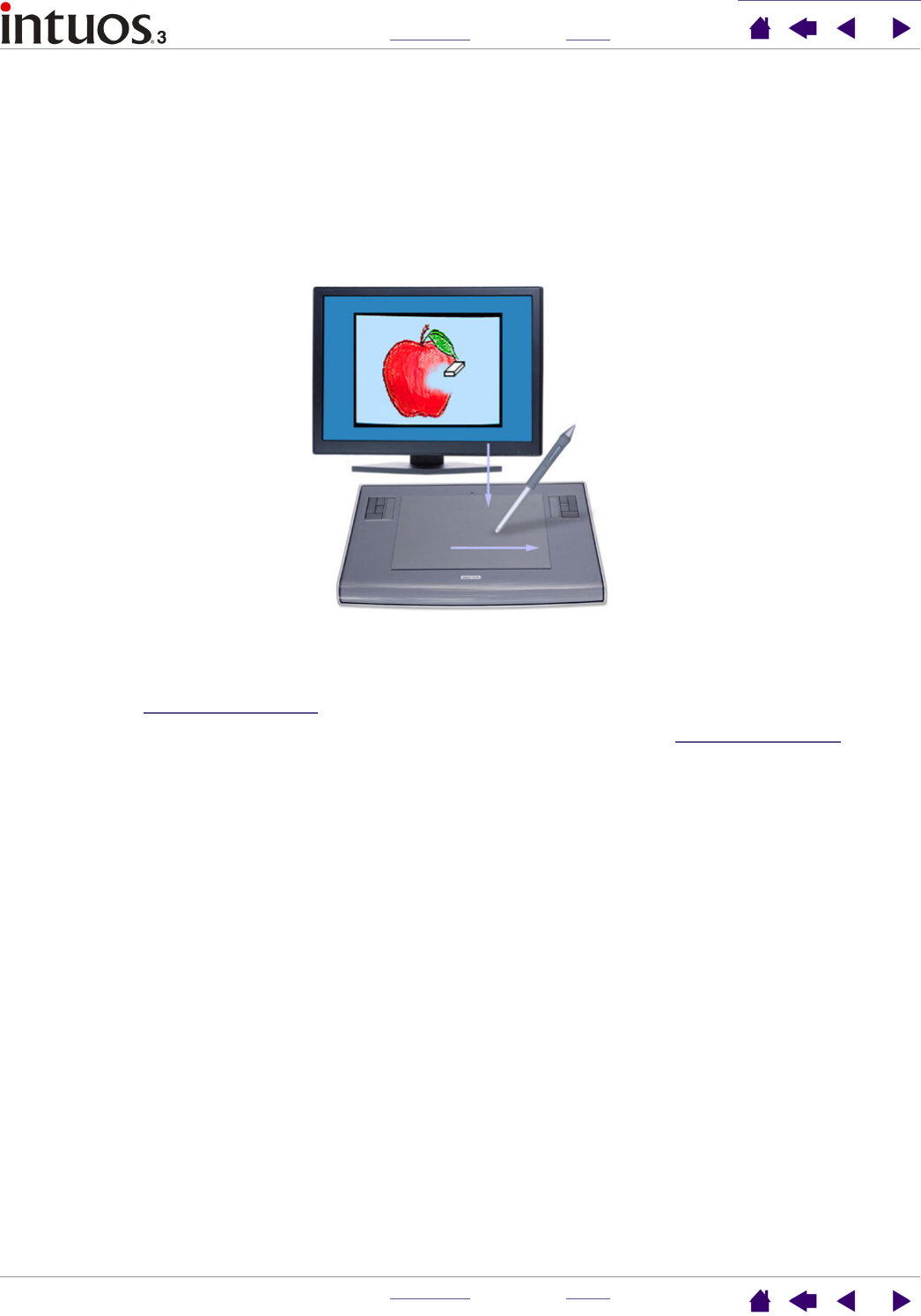
WORKING WITH INTUOS3
INDEX
CONTENTS
INDEX
CONTENTS 17
17
Erasing
The eraser on the Intuos3 Pen works like the eraser on a pencil. In graphics applications that support the
pen’s eraser, you can erase intuitively and naturally. When you use the pen’s eraser, the application will
automatically switch to the eraser tool. In applications that support pressure-sensitivity, you can select
pressure-sensitive tools in an application’s tool palette to vary the width and depth of your erasures as you
change the amount of pressure you exert upon the pen.
You can also use the eraser in many standard office applications. The eraser will not be pressure sensitive
in these applications, but you can use it to select and delete text or spreadsheet cells.
Try your eraser by opening Notepad (Windows) or TextEdit (Macintosh) and typing a few words. Use the
eraser to select the text. When you lift the eraser, the text will be deleted. For further information on using
your eraser, see adjusting eraser feel.
Visit our web site for a list of graphics applications that support the eraser (see product information). If the
eraser is not supported in an application, you can still use the eraser for navigating and drawing.
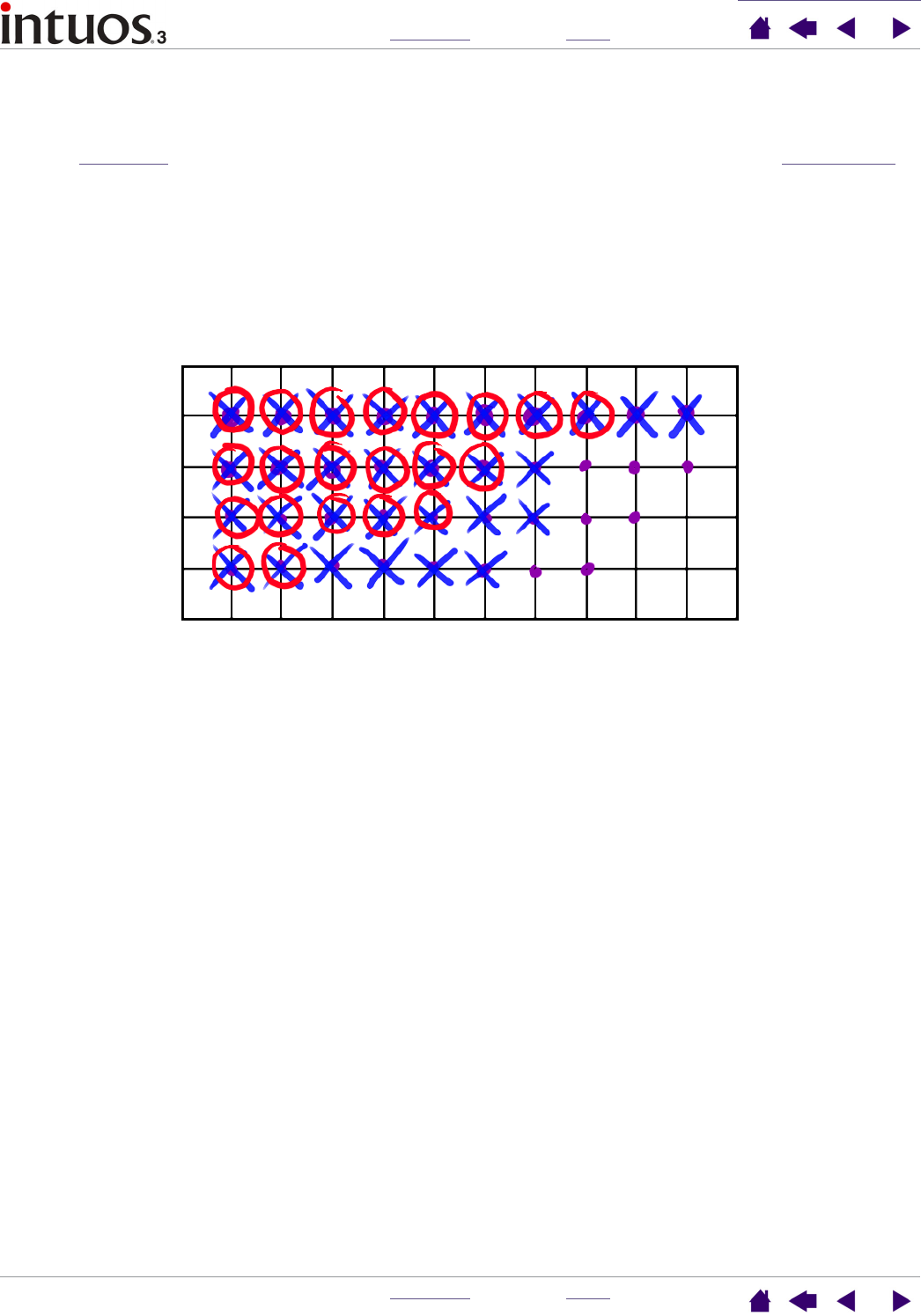
WORKING WITH INTUOS3
INDEX
CONTENTS
INDEX
CONTENTS 18
18
Eye-hand coordination exercise
If you use a mouse, you may remember how long it took to get used to positioning the screen cursor.
Your Intuos3 Grip Pen, likewise, will take a bit of practice to master the technique of positioning the screen
cursor in PEN mode. This may seem difficult at first, but it is more natural and faster than in MOUSE mode.
This exercise is designed to retrain your eye-hand coordination for using the pen:
1. Open any graphics application. Use the line tool to draw a rectangular grid with line spacings of about
20-25 mm (3/4 to 1 inch). You can use your traditional mouse to do this.
2. Choose a free-hand tool in your application and use the pen to draw a dot at each grid intersection.
3. Draw an X at each grid intersection.
4. Now draw a circle around each intersection. Your screen should look like this:
5. Clear your screen and make a simple drawing of your own. The more you use your Intuos3 Pen, the
easier drawing and navigation will become.
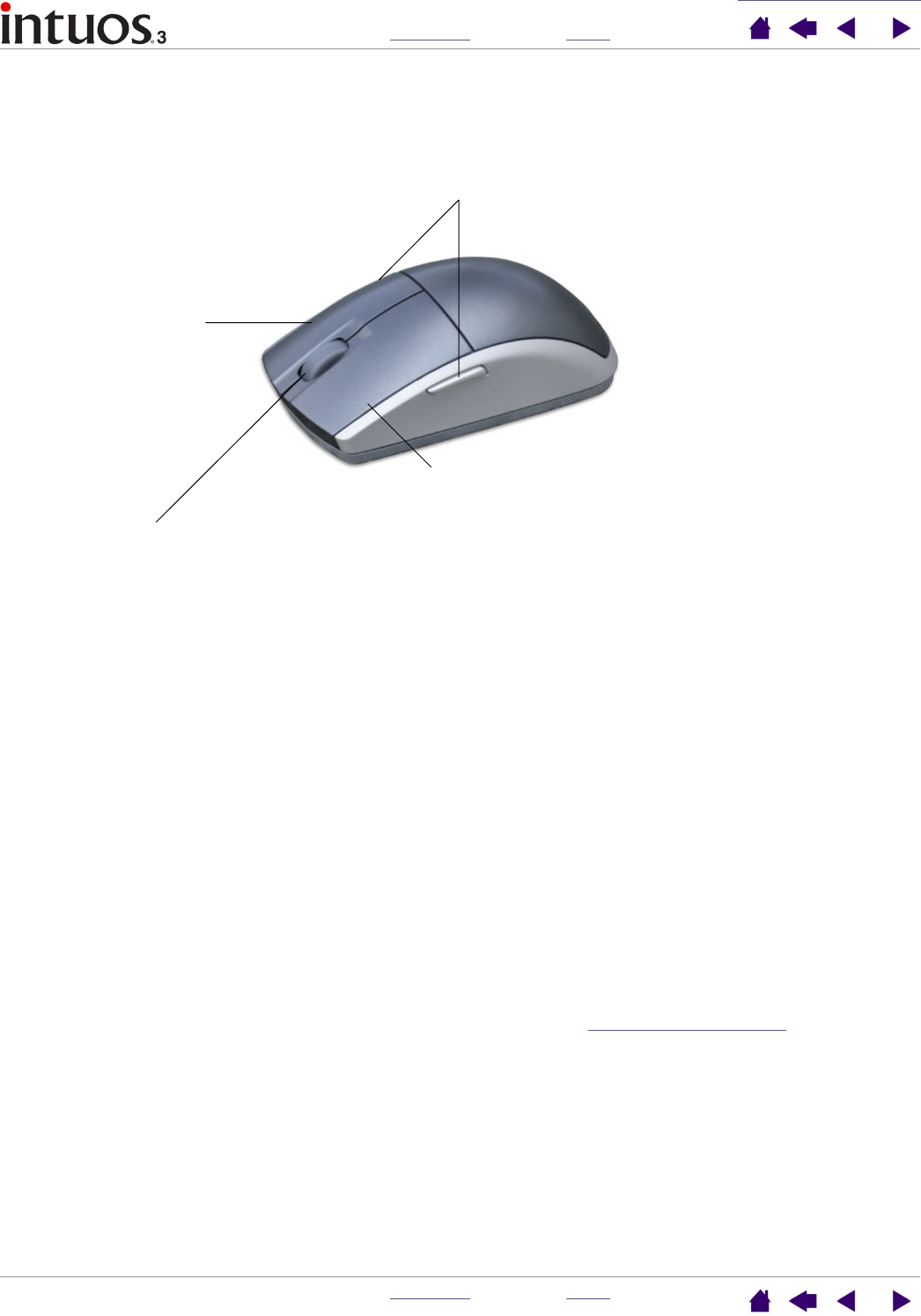
WORKING WITH INTUOS3
INDEX
CONTENTS
INDEX
CONTENTS 19
19
Using the Mouse
The Intuos3 Mouse is a cordless, batteryless, maintenance-free mouse that works on any Intuos3 tablet.
Important: When the Intuos3 Mouse is not in use, place it on your desk. Leaving an Intuos3 tool on
the tablet may interfere with screen cursor positioning when using other pointing devices, or may
prevent your computer from going to sleep.
To learn how to adjust the mouse behavior for your preferences, see customizing the mouse.
The left button is set to CLICK by default, and
is the primary button used for selecting.
The right button is set to
RIGHT-CLICK by default, and
displays a context menu when
pressed.
The left and right side buttons are set for Back and
Forward functionality within your Internet browser.
The fingerwheel can be rolled, or pressed down for an
additional button function.
•Rolling. By default, rolling the fingerwheel will scroll in
most windows and applications. Move the fingerwheel
forward to scroll up, and back to scroll down. You can also
set the fingerwheel to issue a custom keystroke for each
notch of wheel movement. This is useful when working
with repetitive functions, such as zooming in Photoshop or
moving forward and backward within your Internet
browser.
•Wheel button. Press down on the wheel to perform a
button click. The wheel button is set to middle-click by
default. Hint: For MS Office applications that support
a wheel mouse, press the CTRL key and move
the fingerwheel to zoom in and out.
Note: Some product configurations may not include the Intuos3 Mouse.
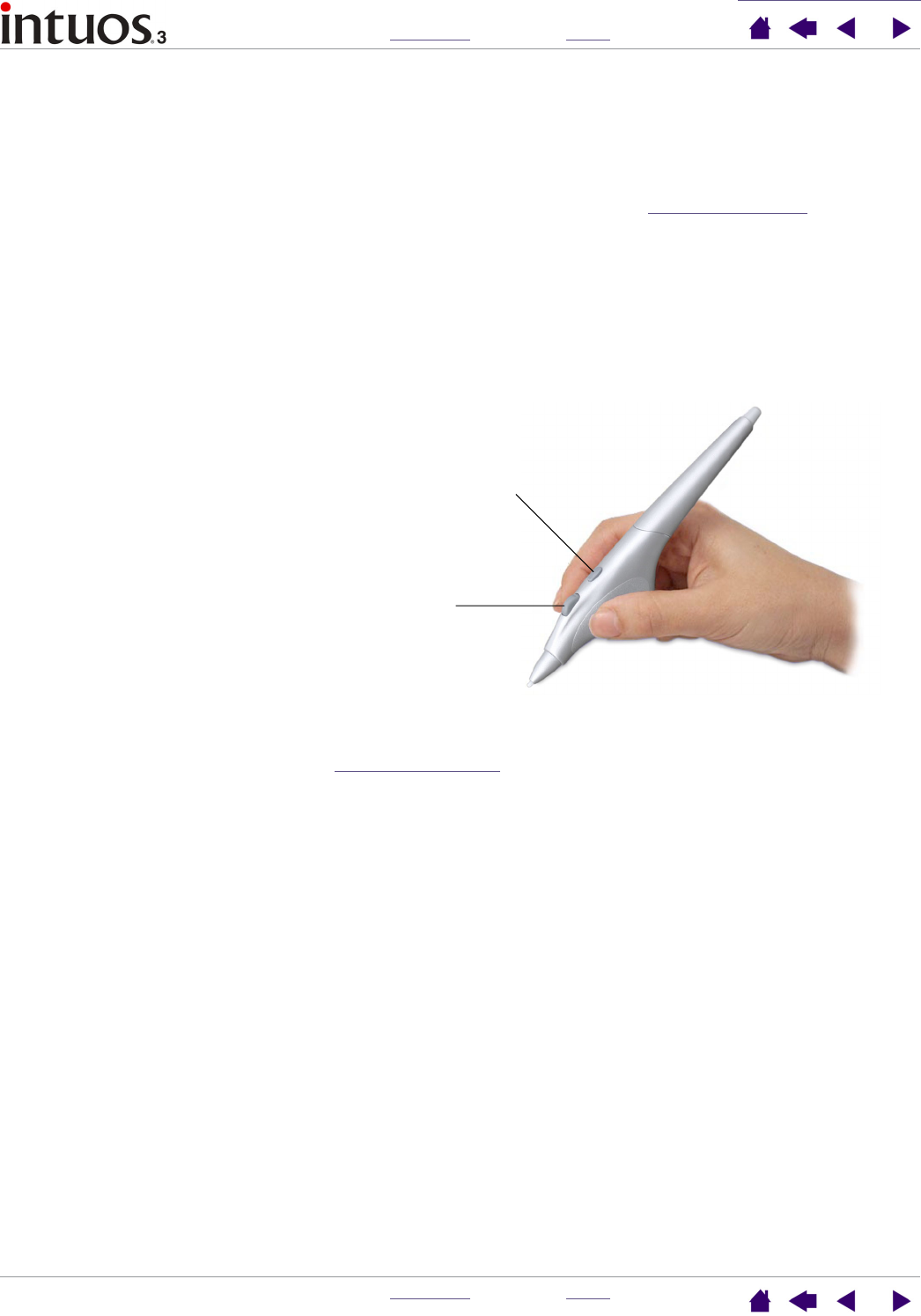
WORKING WITH INTUOS3
INDEX
CONTENTS
INDEX
CONTENTS 20
20
Using the Airbrush
The optional Intuos3 Airbrush works like the pen, but also includes a fingerwheel for an additional degree of
control. With proper software support, you can simulate realistic airbrushing. For example, tilting the
Airbrush can cause the spray pattern to elongate and feather out. Rolling the fingerwheel can adjust the
spray intensity, and pressure on the tip can control the brush size.
All other functions work similarly to the pen. For additional information, see using the Grip Pen.
Important: When the Airbrush is not in use, lay it flat on your desk. To maintain the sensitivity of
your Airbrush tip, do not store the Airbrush in a container where it will rest on its tip. Leaving an
Intuos3 tool on the tablet may interfere with screen cursor positioning when using other pointing
devices.
Hold the Airbrush with your thumb and middle finger. The fingerwheel should be in a convenient location for
you to roll it with your index finger. Tilt the Airbrush to find a comfortable position that allows you to paint and
draw with pressure-sensitivity.
Visit Wacom’s web site to learn where to purchase an Intuos3 Airbrush, and which applications currently
support the Airbrush fingerwheel. See product information.
Roll the fingerwheel backwards to increase ink flow
or brush size, and forward to reduce it.
Your index finger should operate the wheel
independently of the pressure you apply to the tip.
For Windows, the side switch is set for a RIGHT-CLICK by
default. For Macintosh, the switch is set for DOUBLE-CLICK.
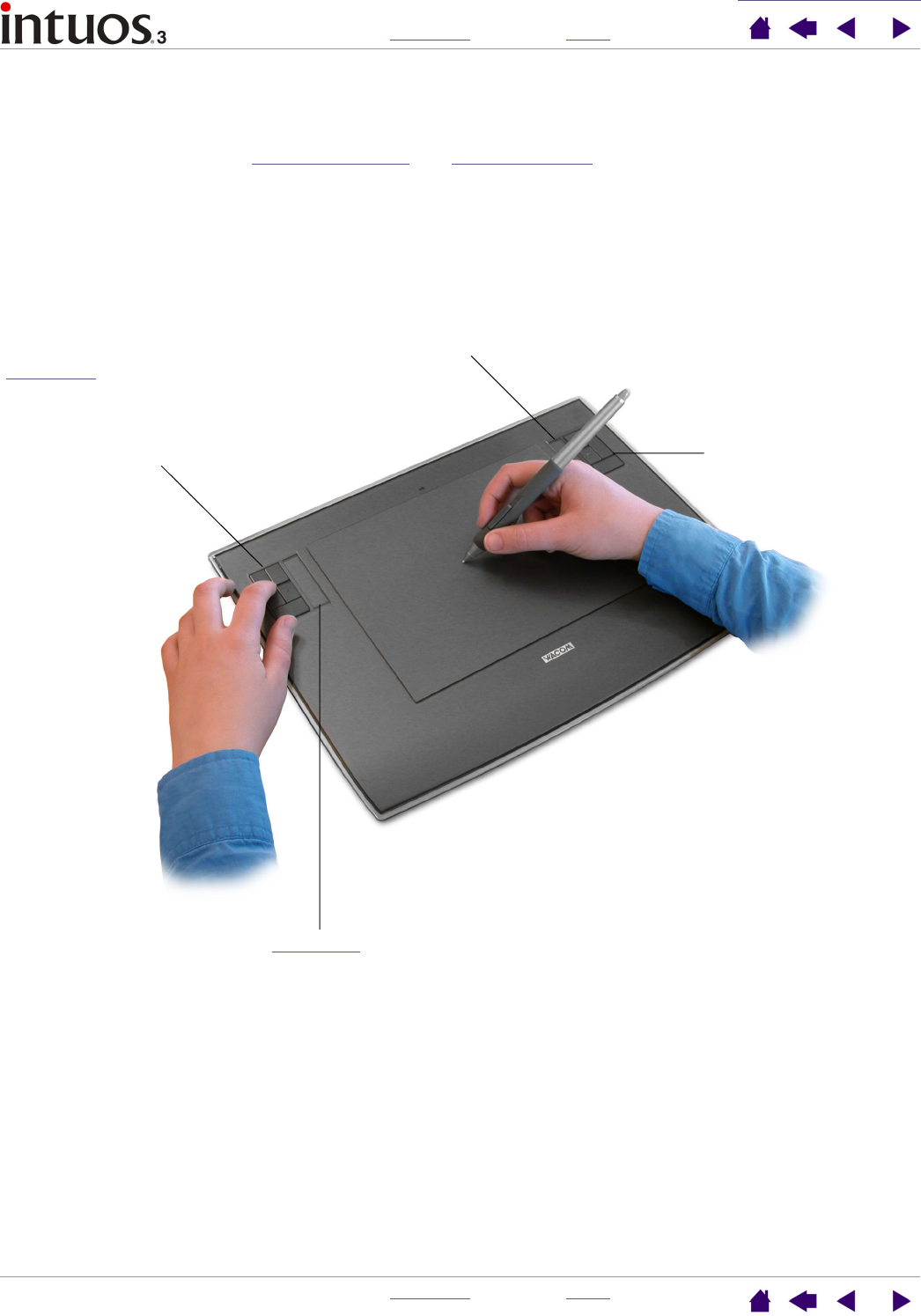
WORKING WITH INTUOS3
INDEX
CONTENTS
INDEX
CONTENTS 21
21
Working with the tablet
The middle area of the Intuos3 tablet is the working, or active, area for the pen and mouse. Rest your hand
on the tablet and then work with the pen on the active area of the tablet just as if you were using a ball point
pen on a piece of paper. See using the Grip Pen and using the mouse for more information about using your
input devices on the tablet.
To speed up your workflow in graphics and other applications, all Intuos3 tablets feature Tablet Keys and
Touch Strip(s) located next to the tablet’s active area. While using the pen with your dominant hand on the
active area, you can simultaneously use your other hand to operate the Tablet Keys or Touch Strip.
For example, you can change the properties of your tool without removing your hands from the Intuos3
tablet. (Note that 4x5/A6 tablet models come with Tablet Keys and a single Touch Strip.)
Tablet Keys. Press the customizable Tablet
Keys to perform frequently used functions or
keystrokes. By default, the keys emulate
keyboard modifier keys. In Photoshop, this
provides quick access to the grabber hand and
alternate tools.
6x8/A5 tablet shown.
Touch Strip. Slide your finger over the Touch Strips to zoom,
scroll, or perform custom keystroke actions. By default, the
Touch Strips enable you to zoom in most graphics applications
and to scroll in other applications. You can also set them to
issue custom keystrokes. For example, you might set a Touch
Strip function to change brush sizes when working in
Photoshop.
Tablet Keys.
Touch Strip.
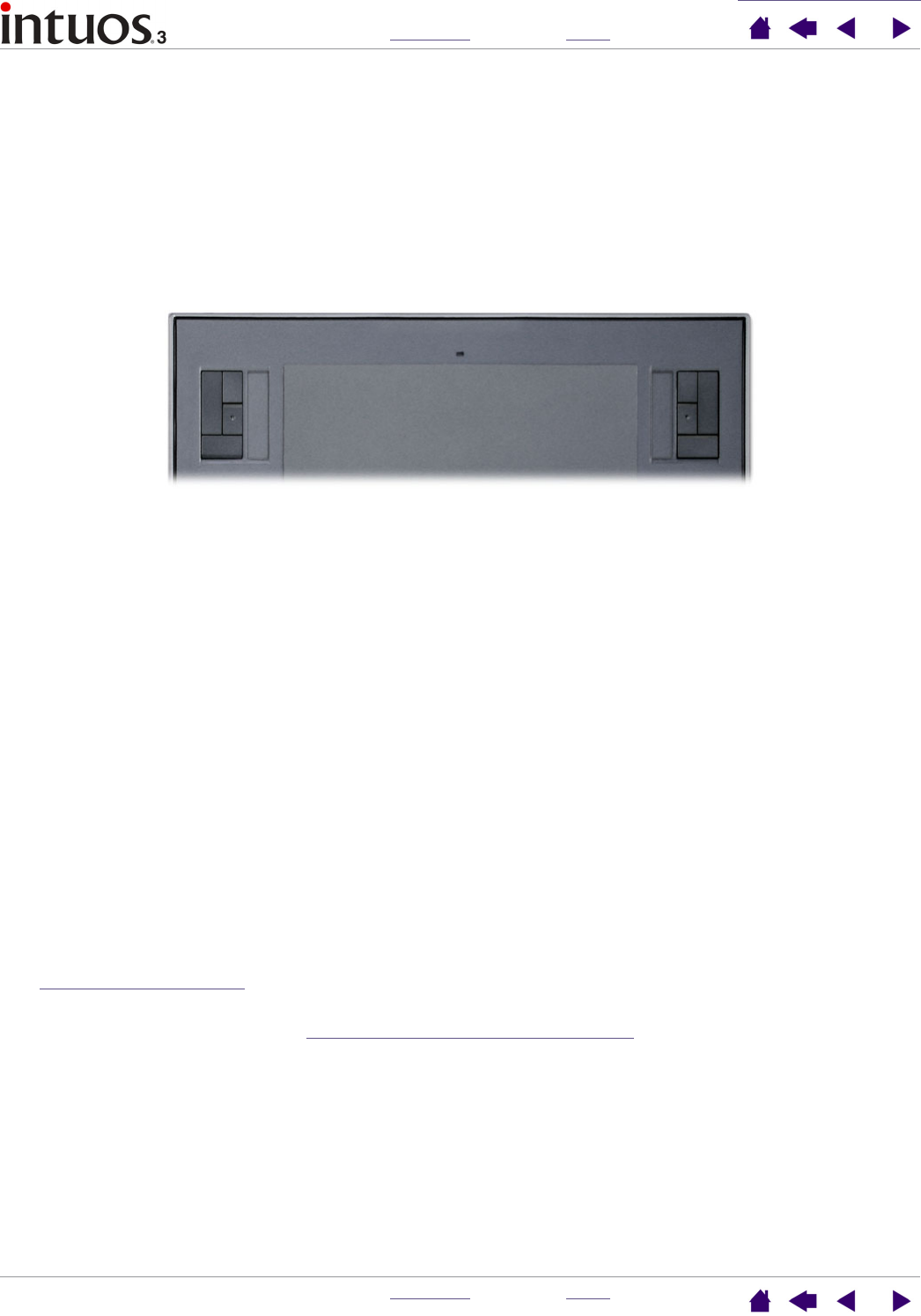
WORKING WITH INTUOS3
INDEX
CONTENTS
INDEX
CONTENTS 22
22
Using the Tablet Keys
Press the Tablet Keys with your secondary hand to toggle between tools or change tool properties while you
are using your primary hand to work with your pen on the Intuos3 tablet. The default settings were chosen
to optimize your workflow in Photoshop and other graphics applications, using the following modifier keys:
Button 1: CTRL modifier key for Windows. COMMAND (Apple key) for Macintosh.
Button 2: SHIFT modifier key.
Button 3: ALT modifier key for Windows. OPTION modifier key for Macintosh.
Button 4: SPACE key (spacebar).
The Tablet Keys are fully customizable, enabling you to make the best possible use of them. You may want
to consider the following ways of working with the Tablet Keys:
•Set a pair of keys to commonly used keystrokes, such as [ and ] to decrease and increase your brush
size in Photoshop.
• Set a key to a commonly used keyboard shortcut in order to open files or start an application.
• If you prefer not to (or cannot) use the side switches on your Intuos3 Pen, then set a Tablet Key to right-
or double-click.
• Choose from any of the other available functions.
See customizing Tablet Keys for more details on the available Tablet Key settings.
If you require different key functions in different applications, you can easily set up application-specific
settings for the tablet controls. See creating an application-specific setting for more information.
6x8/A5 tablet shown.
2
31
4
2
3
4
1
The Tablet Keys are chordable. For example, pressing keys 3 and 1 together simulates
ALT+CTRL in Windows, or OPTION+COMMAND on Macintosh systems.
Tips:
• In Photoshop, pressing the spacebar (key 4 on your Intuos3 tablet) switches the
currently selected tool to the hand tool and lets you pan (move) the image within
the application window.
• In Photoshop and many other graphics applications, the ALT, CTRL, and SHIFT
modifier keys modify a tool or switch to a complementary tool while the modifier
key is pressed.

WORKING WITH INTUOS3
INDEX
CONTENTS
INDEX
CONTENTS 23
23
Using the Touch Strips
Slide your finger over the Touch Strip to quickly zoom in or out, scroll up or down, or perform other functions
with your secondary hand while using your dominant hand to work with your pen or mouse. You can also set
each Touch Strip to issue custom keystrokes. For example, you might set a Touch Strip action to cycle
through layers when working in Photoshop. You can use the Touch Strips in three different ways:
•Standard operation: Slide your finger up or down to zoom, scroll, or issue the assigned keystroke
function.
•Continuous operation: Press and hold your finger at either end of the Touch Strip to continuously
scroll. This is useful for scrolling through long documents or web pages.
•Single step operation: Press and release your finger at either end of the Touch Strip to zoom, scroll, or
issue the assigned keystroke function one step at a time.
By default, the Touch Strips enable you to zoom in most graphics applications and to scroll in other
applications. Each Touch Strip can be independently customized to meet your needs.
Many applications support two methods of zooming. In Photoshop, Painter, and some other applications,
you can specify the center point for zooming by pointing with your Intuos tool while operating the Touch Strip
(make sure you are pointing inside the document window with an Intuos tool). Otherwise, the image will
zoom centering on the document window.
Tip: Photoshop users who frequently change brush sizes may want to assign the [ and ] keys to a Touch
Strip. Sliding your finger up or down the Touch Strip will then change the brush size without the need to
reach for the keyboard or access the Photoshop BRUSHES palette.
See customizing tablet Touch Strips and advanced Touch Strip settings if you would like to customize the
way your tablet Touch Strip(s) work.
6x8/A5 tablet shown.
To use the tip of your Intuos3 Pen to operate the Touch Strip, rest the pen tip against
the edge of the Touch Strip adjacent to the tablet’s active area. Then press hard
enough to issue a click and move the pen tip up or down along the Touch Strip edge.
(Only the inside edge of the Touch Strip responds to pen input.)
Press and hold here for
continuous operation, or
press and release for
single step operation.

INDEX
CONTENTS
INDEX
CONTENTS 24
24
CUSTOMIZING
After you master the basics of using your Intuos3 professional pen tablet, you may want to customize the
way Intuos3 works. This chapter describes how to use the Wacom Tablet control panel to adjust your
Intuos3 tablet and tool settings.
Advanced users can learn how to further optimize Intuos3 by creating application-specific settings.
Opening the control panel
Control panel overview
Control panel settings
Opening the control panel
To open the control panel, use the Intuos3 tool you wish to customize on the tablet:
•Windows. Click on the Windows START button and choose ALL PROGRAMS. (For versions other than
Windows XP, choose the PROGRAMS group.) Then select WACOM TABLET and choose the WACOM
TABLET option.
•Macintosh. Open SYSTEM PREFERENCES from either the Dock, the Apple menu, or from the
APPLICATIONS folder. Then double-click on the WACOM TABLET icon.
After you have opened the Wacom Tablet control panel, you can begin customizing Intuos3.

CUSTOMIZING
INDEX
CONTENTS
INDEX
CONTENTS 25
25
Control panel overview
Use the Wacom Tablet control panel to customize Intuos3.
As you explore the control panel, experiment with different settings to find what works best for you.
Any changes you make will take effect immediately, but you can always click DEFAULT to return a tab to the
factory settings. See control panel settings for more information on the features and functions of each tab.
Tool Tips are available for most control panel items. Simply position the screen cursor over an item and let it
rest there; in a few moments the Tool Tip will pop up.
Additionally, your keyboard tab and arrow keys can be used to navigate the control panel.
Tabs display
customizable settings
for the selected tool.
Displays a dialog
box containing
information about
the tablet and tablet
software, including
an option to access
the DIAGNOSTICS
dialog box.
The DEFAULT button
resets the selected
tab to its default
settings.
The upper portion of the control panel displays icons representing your
TABLET, TOOLs, and the APPLICATIONs with customized tool settings.
Choose FUNCTIONS to
customize your tablet
control and Pop-up
Menu settings.
Choose PEN to
customize your
Intuos3 Pen settings.
Choose MOUSE to
customize your
Intuos3 Mouse
settings.
Displays advanced options. Displays this User’s Manual.
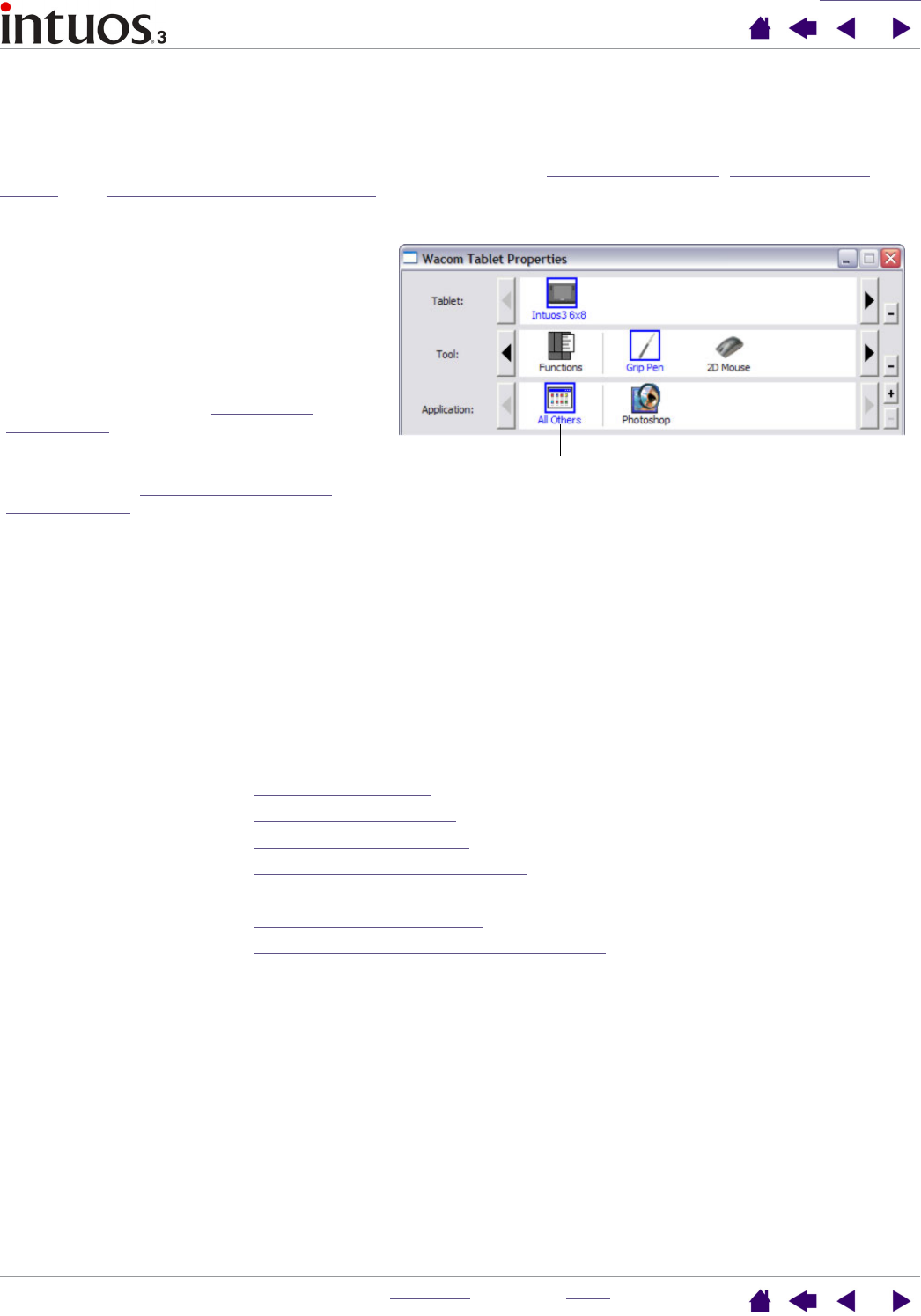
CUSTOMIZING
INDEX
CONTENTS
INDEX
CONTENTS 26
26
Control panel lists and tabs: The control panel TABLET, TOOL, and APPLICATION lists allow you to select the
tablet, tool, or application for which you want to change settings. To change tool settings, open the control
panel using the tool you wish to customize. The tool will be automatically selected in the TOOL list, and the
appropriate tabs will be displayed. To customize settings for a different tool, select it from the TOOL list by
clicking on its icon (the appropriate tabs will be displayed). See customizing the pen, customizing the
mouse, and customizing the tablet functions for more information.
Note: The control panel APPLICATION list is for advanced users; it is not necessary to select or add
applications in order to customize your Intuos3 tool(s).
Control panel settings
Use these sections as a reference when working with the Wacom Tablet control panel; they provide detailed
information about each tab and some of the more complex topics. Many of the sections also contain useful
customizing tips.
Customizing the Pen
Customizing the Mouse
Tablet to screen mapping
Customizing the tablet functions
Customizing the Pop-up Menu
Working with multiple tools
Working with application-specific settings
The TABLET list displays an icon for any
supported tablet that has been installed on
your system. All settings shown below this
list apply to the selected tablet.
The TOOL list displays an icon for the tablet
FUNCTIONS, and for each Intuos3 tool that has
been used on the tablet. When a new tool is
first used on the tablet it is automatically
added to the tool list, and functions with the
default settings. See also working with
multiple tools.
The APPLICATION list lets you define tool
settings that only apply to a specific
application. See working with application-
specific settings.
Your current selections are highlighted.
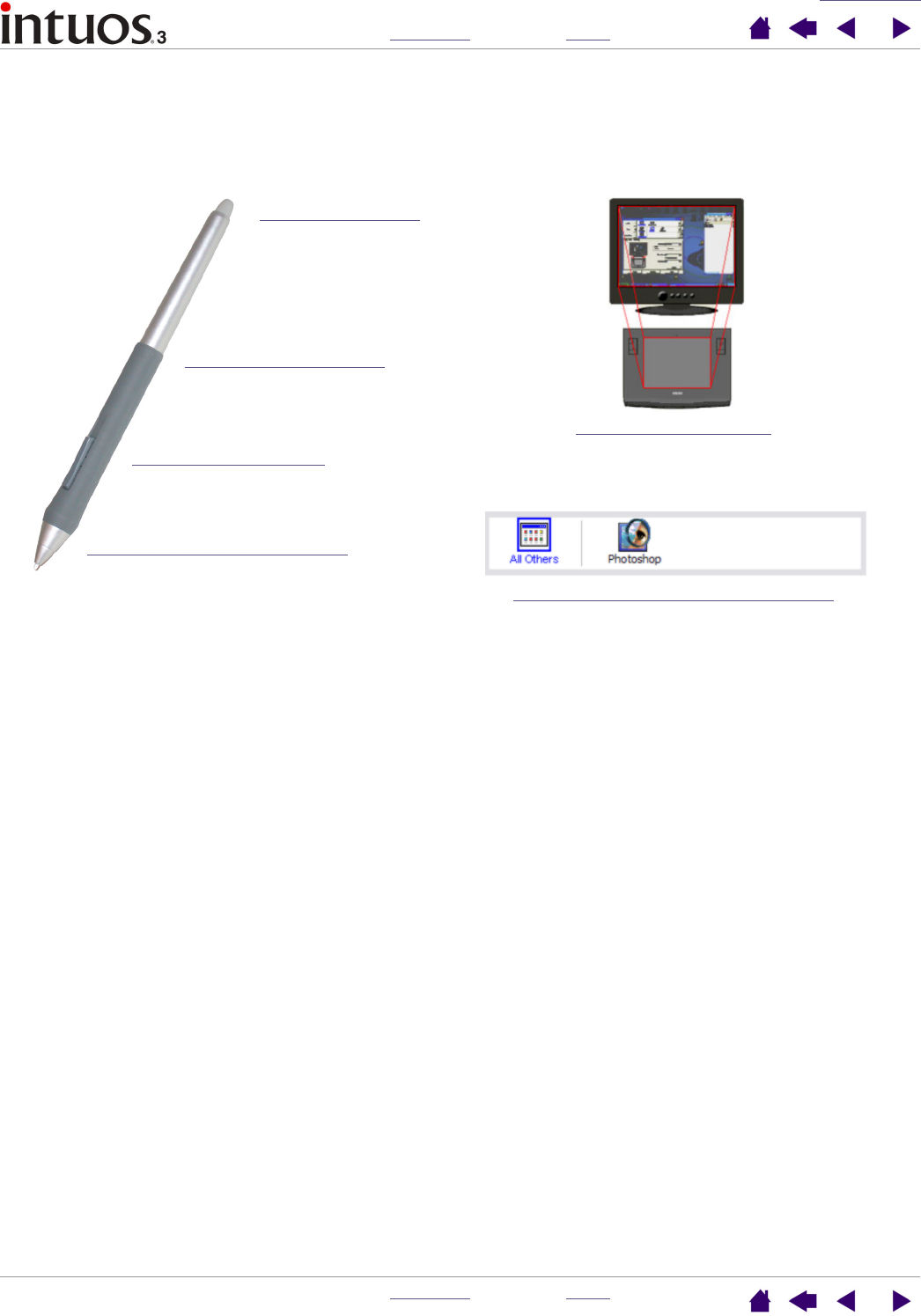
CUSTOMIZING
INDEX
CONTENTS
INDEX
CONTENTS 27
27
Customizing the Pen
Customizing your Intuos3 Pen is easy. First open the Wacom Tablet control panel using the pen. The pen
will be selected in the TOOL list and the appropriate tabs will be displayed. Select a tab and choose from the
available options.
Adjusting eraser feel
Adjusting tip feel and double-click
Customizing tilt sensitivity
Customizing tool buttons
Tablet to screen mapping
Working with application-specific settings
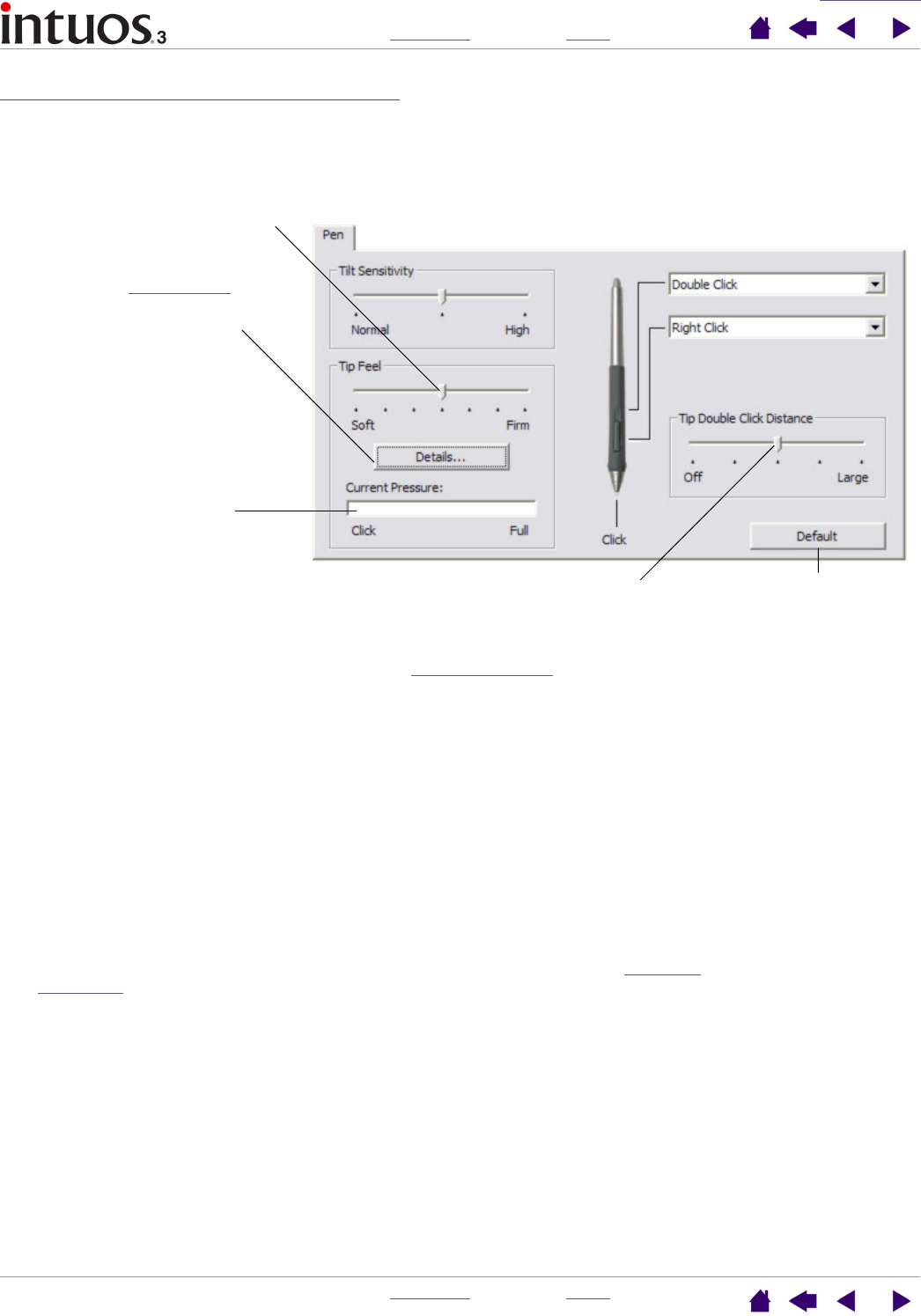
CUSTOMIZING
INDEX
CONTENTS
INDEX
CONTENTS 28
28
Adjusting tip feel and double-click
To adjust the tip sensitivity of your Intuos3 Pen, select the PEN tab. To create broad brush strokes or to click
with a light touch, use a soft tip setting. For maximum control while drawing thin lines, use a firm tip setting.
Customizes the amount of pressure
needed to click or draw. Drag the
slider to a softer or firmer setting.
Press down on the tablet with your
pen tip to test the current tip feel
setting. You can use the CURRENT
PRESSURE bar to determine how
hard you must press on the pen to
reach maximum pressure.
Displays the tip FEEL DETAILS dialog
box where you can further
customize the tip sensitivity.
Hints:
• Use a soft TIP FEEL for a wider range of pressure values with most pressure-sensitive
applications.
• In some applications a soft pressure setting can make the pen overreact – any small
press on the pen is magnified on the screen. If you experience this, try a firmer TIP
FEEL setting.
•Double-clicking: To make double-clicking easier, expand the tap area that accepts a
double-click (the double-click distance).
Note: A large double-click distance may cause a delay at the beginning of your
brushstrokes in some drawing applications. If you notice such effects, try setting a
smaller double-click distance and using the side switch to double-click (see using the
side switch). You can also set one of the Tablet Keys to double-click.
Returns the tab settings
to their factory default
conditions.
Adjusts the size of the double-click area.
A larger setting makes double-clicking
easier.
Drag the slider to the OFF position if you
do not want double-click assist.
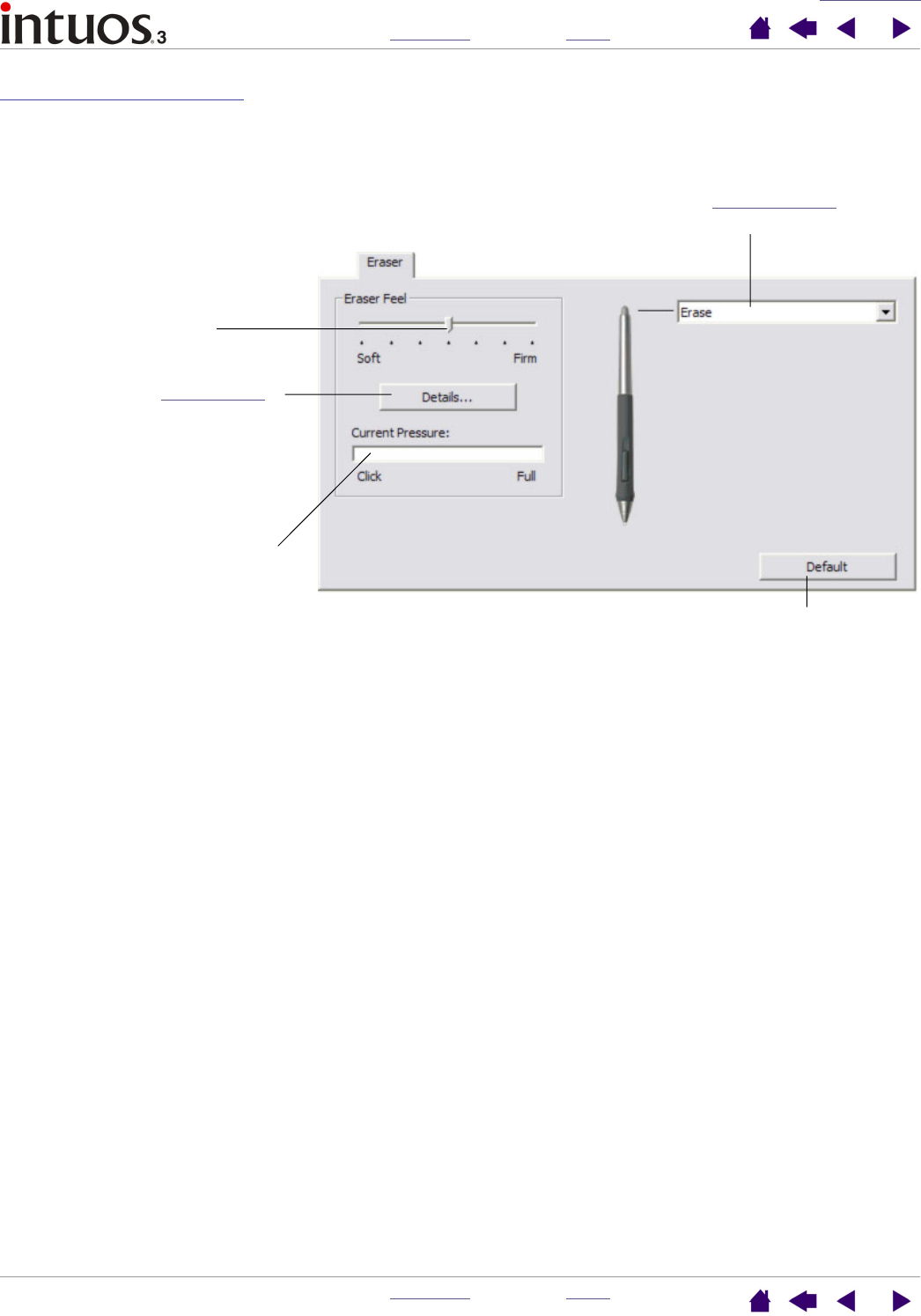
CUSTOMIZING
INDEX
CONTENTS
INDEX
CONTENTS 29
29
Adjusting eraser feel
To adjust the eraser sensitivity of your Intuos3 Pen, select the ERASER tab. To erase with a broad stroke or to
click with a light touch, use a soft eraser setting. For maximum control while erasing, use a firm eraser
setting.
Select the button functions to
perform when using the eraser.
Returns the tab
settings to their factory
default conditions.
Customizes the amount of pressure
needed to erase. Drag the slider to a
softer or firmer setting.
Displays the eraser FEEL DETAILS
dialog box where you can further
customize the eraser sensitivity.
With your screen cursor positioned
over an empty area of your desktop,
press down on the tablet with your
tool’s eraser to test the current
eraser feel setting. You can use the
CURRENT PRESSURE bar to
determine how hard you must press
on the eraser to reach maximum
pressure.
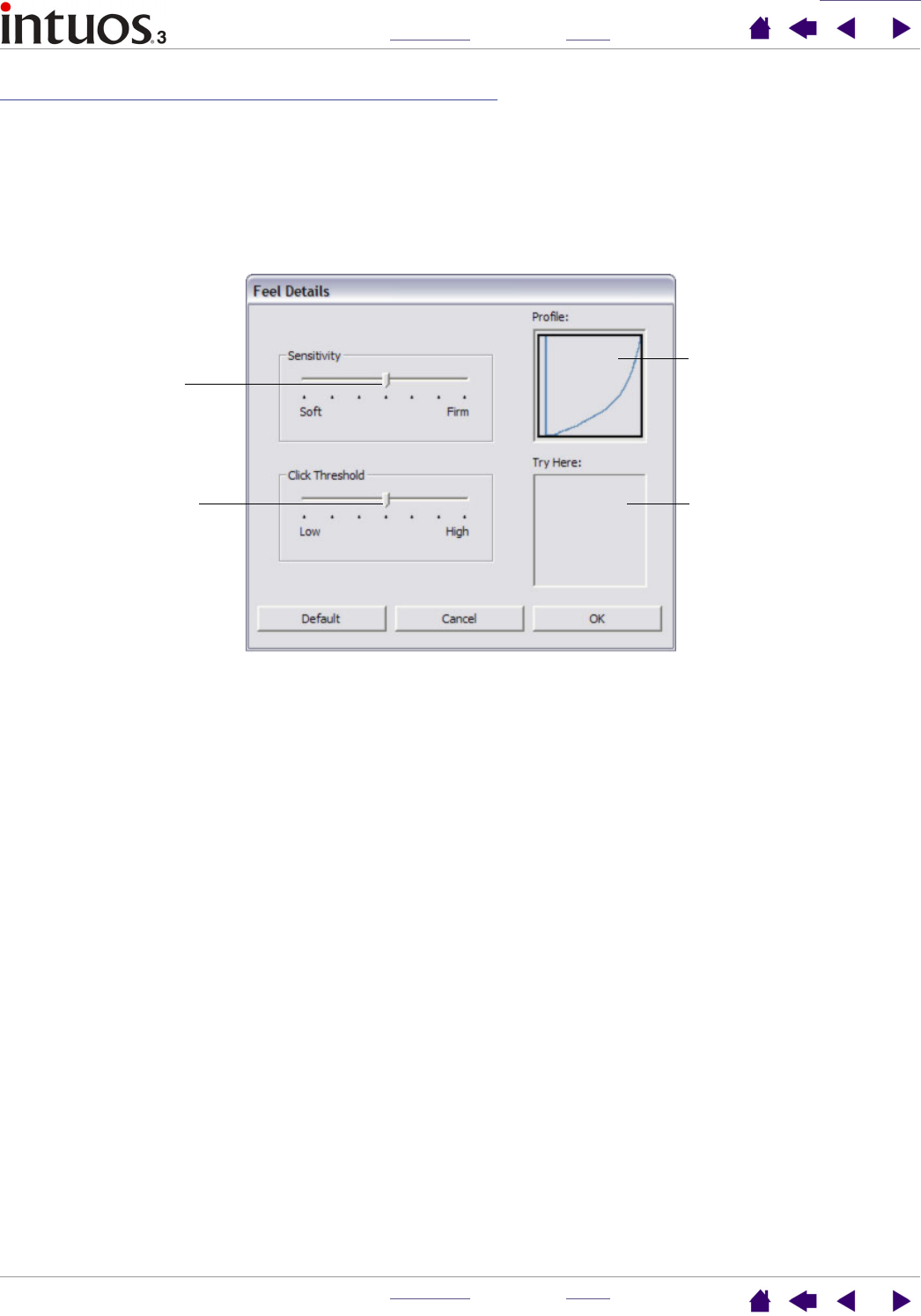
CUSTOMIZING
INDEX
CONTENTS
INDEX
CONTENTS 30
30
Advanced tip and eraser pressure settings
To further customize tip or eraser pressure settings, from the PEN or ERASER tab click on the DETAILS...
button to display the FEEL DETAILS dialog box. The options within this dialog box enable you to change the
tip or eraser pressure sensitivity and click threshold settings independently. (In the PEN and ERASER tabs,
these settings are adjusted simultaneously with the TIP FEEL or ERASER FEEL slider.)
Important: The TIP FEEL or ERASER FEEL slider overrides the detail pressure settings. If you
customize the detail settings, then drag the slider, your detail settings will be removed.
Drag the slider to adjust
the click threshold level.
This setting determines
the amount of force
required to generate a tip
click.
Using your pen tip or
eraser, make several
strokes within the box to
test the results of your
changes.
Drag the slider to select a
pressure sensitivity setting.
If you have a soft touch and
want to achieve full pressure
without having to apply full
force to your pen, choose a
softer setting.
The PROFILE graphically
displays the selected
pressure SENSITIVITY curve
and CLICK THRESHOLD
settings.
A curve that increases
quickly makes the pen feel
more sensitive.
